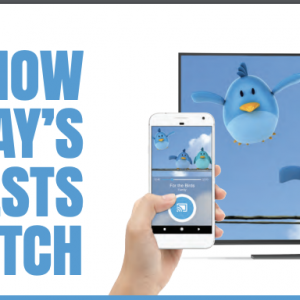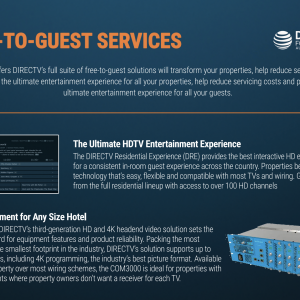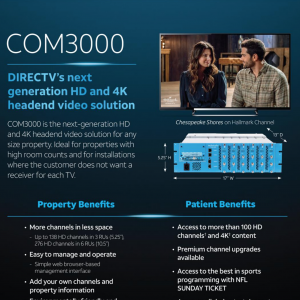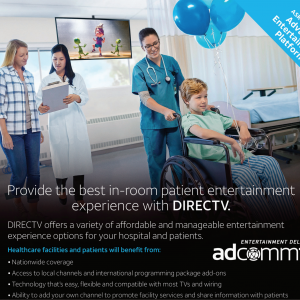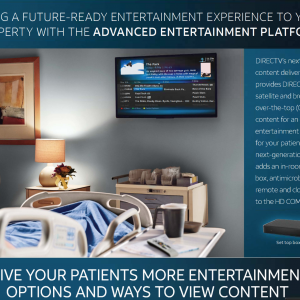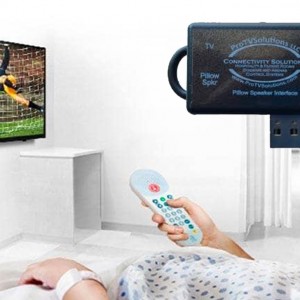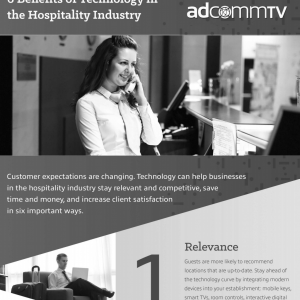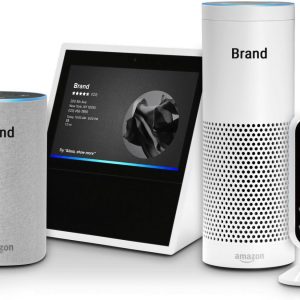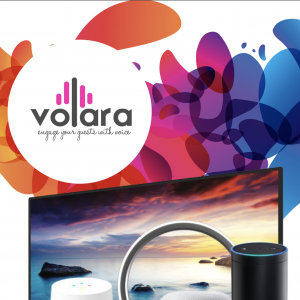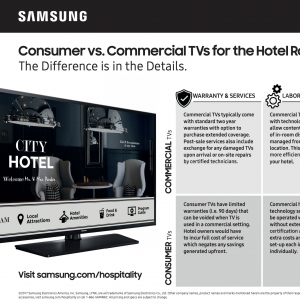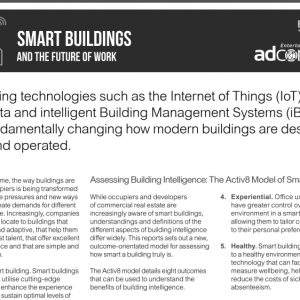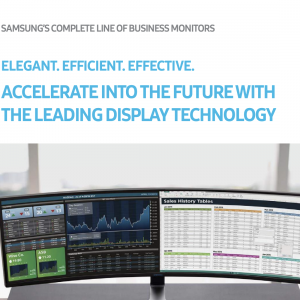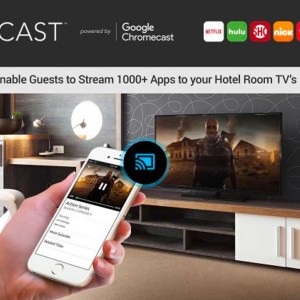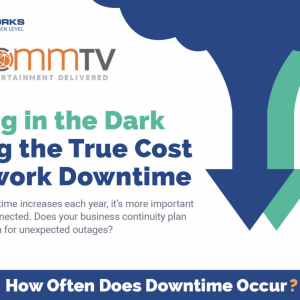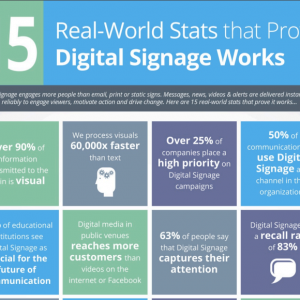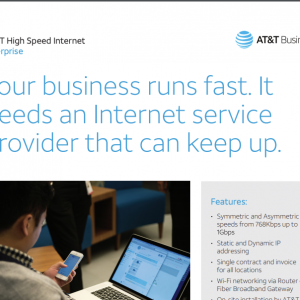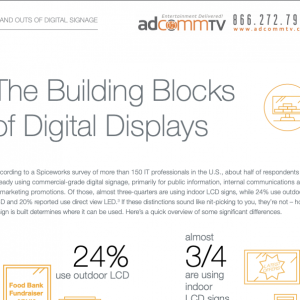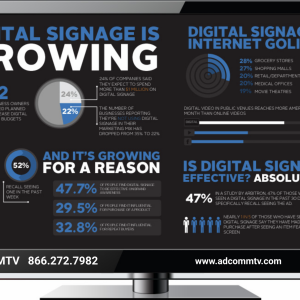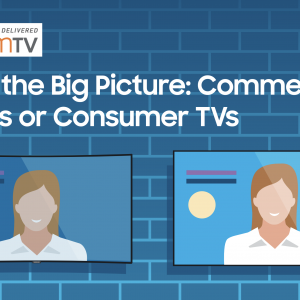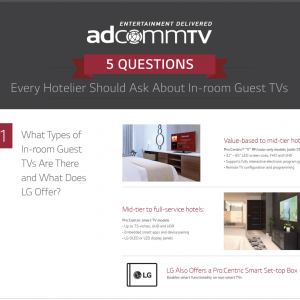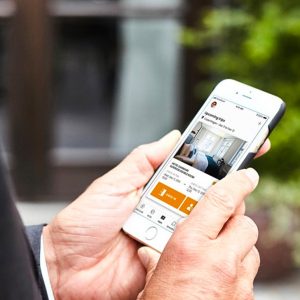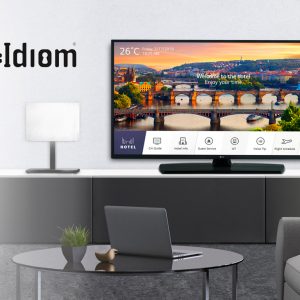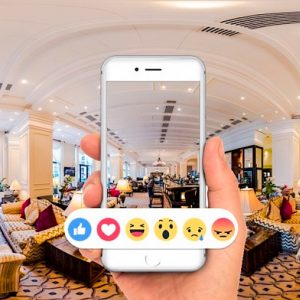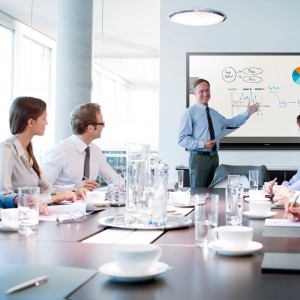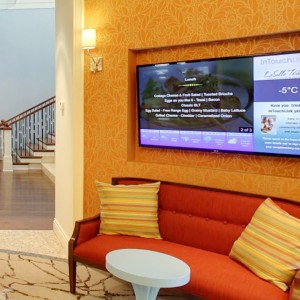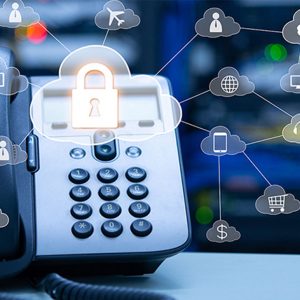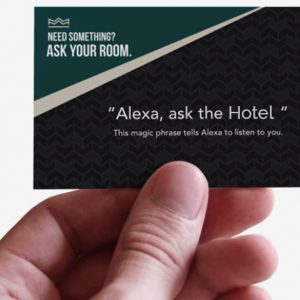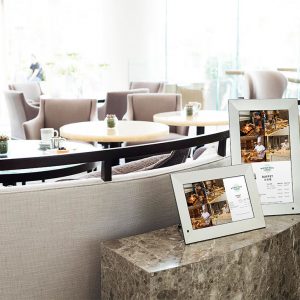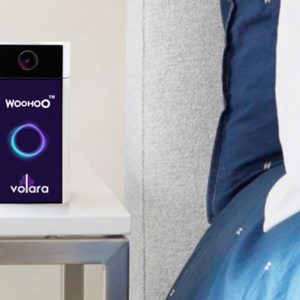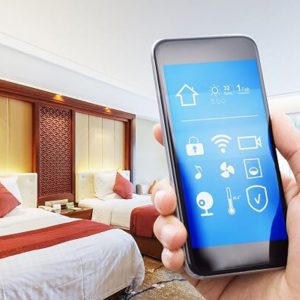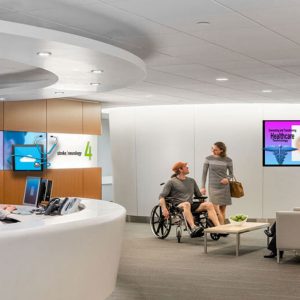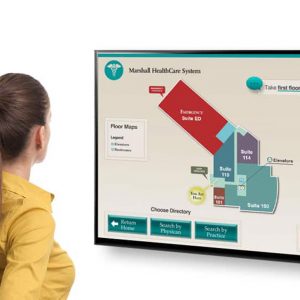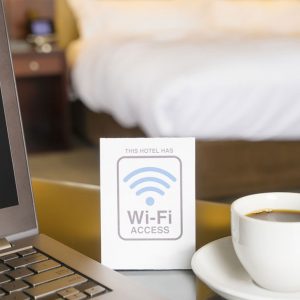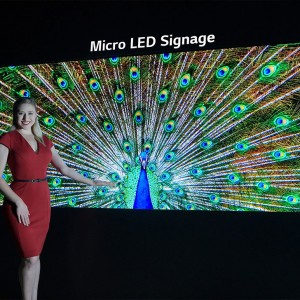What’s Trending
- All
- BUSINESS
- COMMERCIAL TVs
- CONNECTIVITY
- DIGITAL SIGNAGE
- HEALTHCARE
- HOSPITALITY
- HOSPITALITY IT
- RESOURCE
- SENIOR LIVING
- TECHNOLOGY
- VOICE
Need Internet? What businesses should consider
AVAILABILITY A high-speed cable or fiber connection doesn’t do your business any good if the provider does not service your area. With AdcommTV, we offer many options to get your business connected, and at affordable prices SPEED Businesses must ensure that they have the sufficient speed to not disrupt daily use, even when demand is at its highest. Our experts at AdcommTV can offer you a choice of top-notch bandwidth solutions that to meet your needs and speed COST In order for Internet service to make sense for a business, it needs to have a good balance between speed and price. For some, price doesn’t matter as much as speed and reliability. AdcommTV can provide you the right solution TYPE To maximize speed, businesses also need an optimal connection type. The main ones are DSL, fiber, cable and satellite. Yes, fiber achieves the higher speeds, but AdcommTV can customize the right fit for your business within any budget RELIABILITY Most likely the biggest scare for businesses is having unreliable Internet. It’s stressful and counter-productive. Businesses need a service that allows the fewest interruptions, and AdcommTV stands by their services and are available 24/7 for immediate assistance Download https://adcommtv.com/wp-content/uploads/2021/01/data-infographic-min.pdf
It’s How Today’s Guest Watch
ROOMCAST Your guests have a world of content in the palm of their hands. With Netflix, YouTube, Pandora, Showtime, ESPN and hundreds more apps, they access all their favorite content on their smart devices. What if there were an easy way for guests to stream their content directly to your in-room TV? TeleAdapt has developed Roomcast for exactly this. Roomcast is an all-in-one wireless personal area network hub media streaming solution. What if there were an easy way for guests to stream their content directly to your in-room TV? TeleAdapt has developed Roomcast for exactly this. Roomcast is an all-in-one wireless personal area network hub media streaming solution. After joining the network, guests will discover the familiar “cast button” in all of their cast-enabled apps.There is nothing to download; no email or passwords to enter. And yes, it works on both Android and iOS devices. It couldn’t be simpler: join the room network, launch your favorite cast-enabled app and cast. Roomcast is a solution that can simply be added to your existing TV system to provide your guests with the freedom to enjoy their own content. Chromecast Chromecast is the simplest way to get content from a mobile device to the TV. Personal Area Network Roomcast creates a secure Personal Area Network (PAN) for each room. Roomcast Dial The bedside remote allows guests to discover Roomcast with just the tap of the dial. THE EASY WAY TO STREAM Easy for Guests One press of the Roomcast dial brings up Roomcast on the TV, where guests will discover a private personal area network. After joining they can open any cast-enabled app and tap the Cast button to display their favorite content on the big screen. Everything is controlled from the guest’s phone or tablet, using the mobile apps they already know and love. They can even keep using their phone for other things without disrupting what’s playing. Easy for Hotels Roomcast was designed for easy, secure setup: no servers, no software, no teams of installers, no contracts. Roomcast is an “over-the-top” streaming solution that works along with any existing in-room TV system. The solution works without head-end equipment and includes a secure 802.11 wireless access point which is activated on demand, generating a unique WPA passcode. Just plug it in to your existing TV’s and let guests start streaming. Try it in one, or ten, or roll it out in all of your rooms today. Stream Your Content Keep up with your favorite shows on the road. Now you can use Chromecast to stream all your media from your favorite apps and services you already subscribe to. Tap the Roomcast dial to begin Follow the instructions on your TV Join the Personal Area Network Open your favorite apps and tap the Cast button SIMPLE UNIVERSAL SECURE COMPLETE Let Guests Stream Their Own Content Chromecast supports 1,000+ apps, 200,000 TV shows & movies, 30 million songs, plus radio, sports, games and more. Stream right from your own device. No apps to download or need to log in on the TV. Guests use their own mobile devices. Nothing to download and nothing new to learn. Simply “Join & Cast.” All guests will be supported whether they use iOS or Android smartphones / tablets, or laptops with the Chrome browser. Guest’s private information is never exposed and personal area network ensures content streaming is contained to each guest room. Chromecast supports 1,000+ apps, 200,000 TV shows & movies, 30 million songs, plus radio, sports, games and more. The Solution Includes Roomcast Hub Streaming box mounts under or behind desk, or behind TV Roomcast Dial / Roomcast Remote Place at the nightstand, the desk, or next to the TV Existing Hotel TV Simply plug in with HDMI Guests’ Mobile Device Smartphones including iPhone and Android, tablets and laptops with Chrome browser Download It’s How Today’s Guest Watch
Customer Experience Trends for 2019
Customer Care in the Social and Mobile Era Most business leaders today understand that providing a great customer care experience has a substantial impact when it comes to customer retention and increased revenue. Nevertheless, the majority of companies still look at their customer care operations as an unnecessary cost to the business that needs to be minimized or eliminated altogether. It was Zappos who became the shining example of the impact that excellent customer service culture can have on a company’s bottom line. Zappos made it their mission to provide the best service possible, crowning “Deliver WOW through service” as their main slogan. Thereafter, management books were written outlining this integral value, with many companies inevitably trying to mold their business accordingly. Most who tried to replicate the Zappos approach were unsuccessful however, having already invested copious amounts of capital toward achieving this model. Most companies claimed that unless they were established as Zappos from the very beginning – with service being the focal point of their initial company DNA – it would be impossible to make the cultural shift and adopt this new way of doing business. Due to these short fallings, CEOs and Customer Experience leaders eventually rejected this model and retreated to their archaic and substandard customer service habits. However today’s customer expects more, and although companies invested 1.3 trillion dollars on customer service overall and 18 billion solely on contact center software, a recent study showed that 66% of consumers who switch brands do so because of poor customer service that they received. It is clear then that the solution to keeping businesses and consumers happy is not going to come from investing more money into traditional – albeit less effective – customer service channels, but rather approaching the situation from an entirely different perspective through Social Messaging Customer Care. Today’s engagement technologies are enabling us to connect more easily and seamlessly than ever before. The rise of the ‘always connected’ mobile apps and Social Messaging applications enable us to effortlessly communicate with our friends and family – send messages, organize get-togethers, order food, set up meeting points, order an Uber, etc. – without ever picking up the phone and making a call. This is heavily impacting the way companies are providing customer service. So, how are Social Messaging apps different than conventional customer service software? For one they are persistent, enabling customers to see the full conversation every time they open the app. Two, they are device agnostic, allowing consumers to switch from one device to the other without “disconnecting” the conversation. They are asynchronous, allowing for the switch between real and non real-time to occur seamlessly. For businesses, when combined with management platforms like Conversocial, these apps provide a more cost effective customer management solution. Agents can now focus on the conversations that require concrete actions on their end, avoiding the idle times that are inherent to traditional channels such as voice and LiveChat. What’s more, these Social Messaging channels were built with automation in mind, making the implementation of front end and back end automation that much easier. With the right blend of automation, routing, prioritization, and reporting to measure a company’s success, customer service can become a more cost effective channel without compromising the customer experience. By using the right software platforms, companies can use the same Social Messaging apps like Facebook Messenger, Apple Business Chat, Twitter DM, Wechat etc., to provide customer service at a fraction of the traditional cost: breaking the CX to cost equation. Companies can provide outstanding customer service at overall lower costs, which will be more effective than traditional channels and will have a positive, lasting impression among their customers at the same time. With over 4 billion consumers already using Social Messaging apps, ask yourself what you as a business need to be able to manage these conversations at scale. With our help, you too can join the Social Messaging revolution The Most Important Elements of Customer Experience Meeting customer expectations Building rapport with customers Addressing customer conflicts Personalization Creating a seamless experience Brand trust “Customer expectations are being redefined every day and the ability to meet basic expectations is table stakes. We are increasingly being offered experiences that are highly customized, whether it is companies like Amazon who provide variety of delivery of goods at lightning fast speeds, or services like Spotify that are able to understand musical preferences and tailor playlists. Personalization at scale will continue to grow as a trend that will enable distinctive and memorable experiences.” The Biggest Benefits of Your Data and Analytics Function Greater collaboration between departments-42% Increased sales and revenue-33% Increased customer retention-31% Faster to react to customer needs-35% Strategy is driven by data-26% Better engagement with customers-33% According to our research North American companies feel the biggest benefit of their data and analytics fucntion is ‘greater collaboration between departments. In contrast European companies believe it to be the speed they can react to customer needs. Download Customer Experience Trends for 2019
Samsung Business Display Solutions
Technology Services Do you have the right strategic business partner helping you to plan and execute your digital transformation swiftly? See the most important trends in technology services in 2019 Get on trend to deliver business outcomes and delight your customers Get your business up to speed by understand how technology services will change in the coming twelve months. The market will shift towards outcome-based services 60% of enterprises engage in digital transformation through outsourcing and partnering. Over three-quarters of business leaders expect that by 2020, their organization will prioritize services to enhance existing products over the addition of more products. If service providers do not focus on outcome based services, 75% of IT service providers will be irrelevant by 2022. Organizations are partnering to innovate as well as operate 790/oof top performing digitally mature enterprises participate in digital ecosystems. Innovation must bring customers into the decision-making process, by using prototyping, experimentation and co-creation, in order to stay true to the customer’s value drivers. New ventures (like loT) depend not only on sector-specific domain knowledge, but also expertise in analytics, cloud services and wireless connectivity Platform-enabled services are critical to empower standardization and scale By 2020, 60% of all enterprises will have fully articulated an organization-wide digital platform strategy, and will be in the process of implementing that strategy. A good managed service provider will have invested in a managed service platform that features preprepared service elements and scalable templates, making it easier to launch new initiatives. Organizations are shifting from labor-centric to platform-centric models, which is necessitating modernization of traditional legacy applications and infrastructure. Companies will increase their use of consultants to help align technology with business strategy Currently only 23% of CIOs rate their organization as effective at business strategy and planning. 60% of organizations choose to execute their digital transformation through outsourcing and partnering. Over three years, at least USO 3.1 bn of IT Consulting services and systems integration services will be consumed building and implementing loT solutions. Transformative services are the preferred route to rapid digital transformation Companies can yield double-digit investment savings by accelerating digital transformation 20%-30% through adding skilled tech workers. 75% of executives cite skills gaps as an obstacle to implementing their digital transformation. 76% of CIOs consider cloud managed services an essential part of their IT strategy Commercial risk is transferring to IT providers IT operations must embrace the importance of developing a deeper business acumen, running IT operations as a business within the business. Enterprise architecture practitioners must focus their business architecture efforts on defining their business strategy Over the next 24 months, Cl Os will reengineer their approaches to transform their IT ecosystems into high-performance engines that deliver speed, impact, and value. Download Samsung Business Display Solutions
DIRECTV® Residential Experience
Make your guests feel at home with the DIRECTV Residential Experience. The DIRECTV Residential Experience offers premium entertainment benefiting your hotel and guests. Full residential lineup with access to over 100 HD Channels Technology that’s easy, flexible and compatible with most TVs and wiring No Pro: Idiom TVs required Simplified, anti-microbial remote Download: https://adcommtv.com/wp-content/uploads/2019/03/hdtv-entertainment-new.pdf
Free-to-guest Services
AdcommTV offers DIRECTV’s full suite of free-to-guest solutions will transform your properties , help reduce servicing costs, and provide the ultimate entertainment experiences for all your guests. The Ulitmate HDTV Entertainment Experience The DIRECTV Residental Experience (DRE) provides the best interactive HD entertainment for a consistent in-room guest experience across the country. Properities benefit with technology thats easy, flexible, and compatible with the most TVs and wiring. Guests benefit from the full residential lineup with access to over 100 HD channels. Big Entertainment for Any Size Hotel The COM3000, DIRECTV’s thrid-generation HD and 4K headend video solution sets the industry standard for equipment features and product reliability. Packing the most channels into the smallest footprint in the industry, DIRECTV’s solution supports up to 138 channels, including 4K programming, the industry’s best picture format. Available for any size property over most wiring schemes, the COM3000 is ideal for prosperities with large room counts where property owners don’t want a receiver for each TV. https://adcommtv.com/wp-content/uploads/2019/09/ftg-brochure.pdf
Your Building is DIRECTV-Ready
DIRECTV® For Multi Dwelling Units (MDU) State-of-the-art technology solutions for any property size. Both residents and property owners or managers can access DIRECTV® for MDUs (categorized as any building or complex encompassing more than one home or dwelling). The most commonly serviced units are condominiums and apartment buildings. If you are a property manager or property owner, you can hook up DIRECTV® for apartment buildings or for condominiums as an added bonus to current and future renters or tenants. AdcommTV can provide packages at a number of levels to keep your residents connected to great TV satellite packages. With new technical innovations, you can now provide DIRECTV® programming access and services from one central dish system to all of your residents. Give residents even more reason to stay by offering smaller programming package prices than if they tried to get it by themselves. Not only will this entice residence to stay longer but it can also attract new tenants; moving can be a hassle, and if DIRECTV® television and other services are already set up, they can be quite the attraction when advertising your properties to prospective tenants, renters, even buyers if you run a condo association. We can give your building the wow-factor it needs to turn apartment-hunters into happily settled permanent residents. They’ll get access to top-notch entertainment, including exclusive sports and more HD than they ever dreamed of. And you’ll get an easy way to upgrade your property, increasing its value and curb appeal.
COM3000 from DIRECTV®
DIRECTV® COM3000 Headend Hotel Television System by Technicolor The COM3000 Headend takes the next step in providing the TV experience Hotel guests are clamoring for. It is the latest in a line of revolutionary headend television systems from DIRECTV. This system is the smallest and most powerful headend TV system available for hotels, RV parks and campgrounds, assisted living facilities, senior living facilities, healthcare, campuses, institutions, bars, restaurants, and other commercial applications. AT&T continues to change the world of video with the launch of COM3000. This is the third generation of our DIRECTV® for Business video headend. With it, businesses will get more channels than ever. Plus, they’ll find it’s easier to customize. COM3000 Headend can deliver up to 138 HD channels, including 4K HDR programming. And business owners can add channels one at a time, including their own in-house and over-the-top (OTT) channels. The platform can also help businesses prepare for the future of video programming delivery through easy customization. As business and entertainment needs evolve, business owners can download software upgrades, instead of installing costly hardware. 4K Support The 1st thing you will notice is that the COM3000 provides true 4K TV. COM3000 will support DIRECTV’s current 4K channels as well as the HDR and high-bandwidth programming of the future so it’s truly futureproofed. 138 HD channel capacity Since the COM1000 was introduced for use on DIRECTV® Hotel TV Systems, the competition has tried to copy it. Even expanding on the number of channels available in a single receiver card. Technicolor has packed access to up to 23 channels in a single COM51A receiver card. Remote Management and Service Like the COM2000 access to the Technicolor COM3000 headend is via a web browser, meaning that if channels need to be changed, service needs to be done, or you want to utilize channels to provide welcome screens and local information, it can all be done remotely. FEATURE RICH • More channels in less space • Up to 23 HD or SD channels per blade • Up to 138 HD channels in 3 RUs (5.25”), 276 HD channels in 6 RUs (10.5”) • Easy to expand platform that can support hundreds of channels • Feature-rich • Supports 4K HDR satellite broadcast channels • QAM and/or IP video distribution • Local management through an integrated web interface • Remote management for all properties from one interface • Local and Over‐the‐air content insertion • Hassle‐free installation • Third generation COM System design • Backward compatible to allow for easy expansion of existing deployments • Plug and play platform • Environmentally friendly & energy efficient • Even more efficient design than the already eco‐friendly COM2000 • FCC‐tested as Commercial Grade Equipment (designed for harsh environmental conditions) with low energy consumption • Fully loaded COM3000 requires less than 300 watts of power consumption ‐ the lowest power consumption per channel in the industry
Provide the Best In-Room Patient Entertainment Experience with DIRECTV
DIRECTV® DRE Make your patients feel like they’re at home Help banish patient boredom with the DIRECTV® Residential Experience (DRE). DRE delivers a robust entertainment experience your patients will love with access to over 100 HD channels, movies, and shows. The easy-to-use, anti-microbial remote offers entertainment access through a simple programming guide, just likes patients are used to getting at home with DIRECTV. Nothing feels more like home then snuggling up to a favorite show. With access to over 155 channels in the XTRA Package, featuring the best movies, original series, and sports programming, everyone will find the shows they love. Put your patients and their loved ones at ease with the DIRECTV® entertainment they love. It’s a great way to upgrade your patients’ experience—for a price that won’t break your budget. Have questions about the installation? Contact us and we’ll work with you to find the best technology solution for your hospital.
Bring a Future-Ready Entertainment Experience to Your Property with the Advanced Entertainment Platform
DIRECTV’s next-generation content delivery solution provides DIRECTV® linear satellite and broadband over-the-top (OTT) content for an enhanced entertainment experience for your patients. This next-generation solution adds an in-room set-top box, antimicrobial custom remote, and cloud services to the HD COM Systems.
Digital Signage in Healthcare
If the mission of digital signage technology really is to get the right messages to the right people at the right times and locations, healthcare is the perfect example of why that matters. With few exceptions, from small clinics to giant medical campuses, health care facilities are places punctuated by joy and sadness, anxiety, and a need for answers and clarity.
Pillow Speaker Interface for Healthcare
Pillow Speaker Interface for Healthcare Control Cable or Satellite STB’s with any Pillow Speaker Key features • Allows for typical hospital pillow speakers to control a cable or sat box as well as the TV • Now patients can enjoy a home-like viewing experience using a pillow speaker • Compatible with all major pillow speakers – Anacom-Medtek, Crest, Curbell, and others – Not necessary to replace existing pillow speakers • Fully supports DIRECTV® DRE Set Back Boxes – Allows installations in small facilities where head ends are not cost-effective • Compatible with most healthcare grade TV’s • Auto-senses all major pillow speaker protocols • We can easily add protocols for additional Set Back Boxes if necessary • No external power supply necessary • Very low-cost solution • Only 2.1” x 1.6” x 0.6” in size, easily mounts to the SBB or back of the TV • Ability to remap any pillow speaker key to most SBB functions • For a true at-home viewing experience, ask about our unique SBB pillow speakers! • Pillow speakers must be able to support digital signals and have a minimum # of buttons to be useful
6 Benefits of Technology in the Hospitality Industry
ADCOMMTV & INSIGHT PRESENTS 6 Benefits of Technology in the Hospitality Industry Customer expectations are changing. Technology can help businesses in the hospitality industry stay relevant and competitive, save time and money, and increase client satisfaction in six important ways. 1. Relevance Guests are more likely to recommend locations that are up-to-date. Stay ahead of the technology curve by integrating modern devices into your establishment: mobile keys, smart TVs, room controls, interactive digital signage, and things of that nature. 2. Security Your customers trust you to protect their personal data – credit card numbers, billing addresses, contact information, and more. Instead of storing those details exclusively in computers on-site, where they can get lost or stolen, use the cloud. Most modern software applications include cloud storage and backup capabilities. 3. Sustainability Saving energy and money has never been easier. Go green by installing programs that adjust room lighting based on the amount of natural light provided. And use motion sensors to automatically shut off electricity in unoccupied spaces. 4. Scalability Hotel Customer Relationship Management (CRM) programs consolidate guest data, automate payments, and aid in account management, reporting, and more. That means you can continually grow your business around practices that produce the highest ratings and revenue. 5. Efficiency Guests don’t like waiting in line. In the hospitality industry, using tablets at the front desk will streamline the check-in and check-out process. Not only will this improve satisfaction, but it will save time so you can focus on improving the guest experience. 6. Simplicity Integrated smartphone tools conveniently provide all of the resources customers need in one place. With a custom hotel app, users can easily locate amenities such as the pool, gym, spa, bar or laundry rooms; check their charges, and leave reviews.
Nonstop Alarms & Charging Stations
Alarm and Charging Stations Designed for Hospitality Technology progresses, guests are on the move, and design trends forward. Our products are uniquely compelling for hotels because our business is a unique collaboration of award-winning product design, backed by experienced consumer electronics’ manufacturing and led by seasoned hotel-savvy management. We’re on the pulse of the latest tech and design to appeal to a wide variety of today’s guests. From tech-savvy road warriors and adventure craving Millennials to families on vacation and guests looking for traditional comfort. Nonstop is a technology that makes guests feel at home. Guests First We designed our products from the ground up to delight today’s guests who are focused on their mobile phones and portable devices. With Qi Fast Wireless Charging and Dual USB ports, they’ll never go hunting for an outlet again. Plus, friendly features like dimmable displays and Lightsleeper™ mean they are sure to sleep well too. Designed for Hotels We understand the functional needs of hotels. Our products are equipped with a wide array of hotel-specific features like single-day alarms, Auto-DST, and security features to prevent theft. Minimize the service burden on your staff with an easy time set and our innovative battery-free clock memory. Decor Driven Design The days of boring boxes with cluttered buttons are over. If you’re the kind of hotel that differentiates from design, then you need modern designs that are different too. From form factor to unique decor inspired finishes, even our stock options are anything but standard. Features Clock with Hotel Friendly Alarm with Qi Certified Fast 10W Wireless Charging 2X USB with a 2.4A Fast Charging plug. Single-day alarm, Simple 2-step alarm set, Dimmable dis-play with Lightsleeper™ option to turn the display off, 1” Easy time read display, Qi-certified 10W Fast charging with FOD (Foreign Object Detection), Auto-Day light savings, Internal rechargeable memory backup- no backup batteries to replace, Tamper-proof time settings, Tamper-proof power disconnect, Security Tether, Simple time set Make It Yours One of the first things guests look for in a room is a place to charge their phone on the nightstand. This high-traffic area makes it an ideal spot for in-room messaging and brand promotion. We make it easy for you to customize our products with printed tray cards. And if you’re the kind of hotel that wants to craft every detail you can work with the Nonstop design studio to create custom finishes, colors, and designs that are as one-of-a-kind as your brand. Promote Your Brand Make your property memorable and increase repeat stays by featuring your brand and loyalty programs and promoting amenities. You can even update the cards seasonally for upcoming events and promotions. Generate On-Property ROI Increase revenue by promoting on-proper-ty restaurants, bars, shopping, and spa in a high-visibility spot in the room. Increase Guest Engagement Drive guests to your mobile app and increase social media interaction with links and QR codes in a perfect spot right where guests have their phone in-hand. Complement Your Decor Tech products don’t have to be boring black boxes. Feature your custom color palette, prints, patterns, and artwork to extend your unique style onto the nightstand.
Just Ask: Voice Technology Makes Waves in Hospitality
AdcommTV’s Article: Lodging Magazine Just Ask: Voice Technology Makes Waves in Hospitality While scientists have yet to introduce jetpacks, flying cars, and, of course, hoverboards to the general population, we are living in an amazing era of incredible technology. We communicate faster and better than ever before, and automation is making hard and complicated tasks easier and more efficient. New innovations enter our everyday lives at a dizzying speed, but one, in particular, is making major waves, especially in the hotel industry—voice technology. Encompassing Apple’s Siri digital assistant, Samsung’s Bixby, Google Home, and Amazon’s Echo, voice technology is one of the fastest adopted technologies in recent history. According to the Fall/Winter 2017 “Smart Audio Report,” a study by National Public Radio (NPR) and Edison Research regarding consumers’ voice-activated device habits, 16 percent of Americans owned a voice-activated smart speaker as of January 2018—that’s about 39 million people. That number is up 128 percent from January of 2017, outpacing the adoption rates of both smartphones and tablets. Additionally, Gartner Inc., a leading technology research and advisory company, predicts that 75 percent of American households will have a voice-activated smart speaker by the end of 2020. And, it was noted in the Smart Audio Report from Spring/Summer 2017 that 42 percent of smart speaker users now consider the device “essential” to their everyday lives. People are using these devices for all kinds of tasks, from playing music and setting alarms to controlling household devices. Any technology that has this rate of adoption in the consumer market is sure to grab the attention of the hotel industry, especially considering that most people already know how to use it. “Voice is a natural human interface. We learned how to speak and respond to language as infants,” says Ted Helvey, the CEO of Angie Hospitality. Helvey is deeply immersed in the world of voice-activated technology, as his company developed Angie, a voice-enabled, in-room technology solution that acts as a 24-hour assistant for hotel guests. Voice-activated technology’s ease of use has made it very appealing to hoteliers, who are now looking for ways to incorporate it into their operations. But, that road had been a little rockier than initially expected. “While these technologies seem simple enough to incorporate at home, hotels are a much more complex environment. There are security concerns, connectivity issues, and, perhaps most importantly, high guest expectations to meet,” Helvey explains. “People like voice-activated technology because it’s easy and natural—as long as it works. That is the key.” As Long As It Works Reliability has been one of the major issues with voice-activated technology, but recent advancements have made the technology better. “We’re continuing to see improvements in accuracy and interpretation, and most voice-activated devices are now functioning at a very high level,” Noreen Henry, CEO of travel AI company WayBlazer, says. “Sometimes there can be a struggle with accents, but these devices are learning and getting better all the time.” There’s also a certain amount of training that goes into using voice-activated technology—not necessarily users training the device, but the device training its users. “When I ask Siri a question and she can’t answer it, I don’t ask that way again. I get trained,” Helvey says. “You never know how someone is going to ask a question, even if that question is as simple as, ‘What time does the pool close?’ That’s one of the biggest challenges for hotels looking to incorporate this technology.” While it is a challenge, there are people out there looking to meet it head-on. Helvey’s Angie was developed specifically for hotel use and has been quite successful, Henry’s WayBlazer is bringing voice into the booking process, and other companies are working on developing hotel solutions that can be integrated with existing voice-activated devices. High-Tech Guest Benefits Once a hotel decides to implement a voice-activated solution for its guests, there are seemingly endless opportunities for use. Some of the more obvious applications are controlling the guestroom’s lights, television, drapes, temperature, and even “do not disturb” notifications. There are already some companies integrating voice across the hotel technology stack in management systems, guest engagement platforms, valet systems, safety systems, IPTV systems, and more. One such company is Volara, a provider of integrated and custom voice-based solutions for the hospitality industry. Jeffrey Clement, vice president of strategic accounts for Volara, says, “Voice-activated solutions offer an easy and frictionless way for guests to interact all of the hotel’s technology, including—but not limited to—in-room devices.” Clement is currently working with Jason Cohen, Senior Vice President of Adcomm TV, a national authorized dealer for DIRECTV® for Business, IPTV, HSIA Services, and a Samsung for Business Platinum Level Channel Partner for the Hospitality and Healthcare Industry, on rolling out the Volara solution in numerous hotels. Both Clement and Cohen are very excited about how they’ve seen the technology impact their hotel clients. “Volara’s software enables smart devices to be business tools for the hotels,” Cohen says. “The technology is creating measurable efficiencies and the positive impact on the guest experience is already showing up all over TripAdvisor.” The hotel’s Cohen and Clement are working with have embraced the flexibility of voice solutions. “You can have it answer in Alexa’s voice, or you can pre-record messages from team members. For example, you can have the chef at your in-house restaurant describe the weekly specials or the golf pro share news about an upcoming tournament.” Cohen says. Clement adds that the messages can even be targeted to certain travelers. “If you have a group coming in for a wedding or a conference, you can pre-record messages just for those guests. So, say it’s a wedding party, you can have the bride and groom—in their own voice—welcome their guests. The technology enables truly memorable experiences.” And, for hotels investing in voice-activated solutions, the possibilities are limitless and easily tailored to a property’s brand. Cohen says that at some hotels, guests can ask Alexa to create a movie night for them. “The lights dim and the shades
Hospitality Commercial Appliances Top Supplier
Magic Chef Commercial Appliances Everything for Hospitality Magic Chef Commercial is hospitality’s, must-have, cooking essentials by offering a range of high-quality, value-priced commercial cooking products featuring proven design and the newest technology. Products boast outstanding performance and long life through the use of superior engineering, dynamic manufacturing techniques, and high-quality materials. AdcommTV can help hoteliers with all commercial appliances including those for in-room, breakfast bars, commercial kitchens, and other common areas. • Microwaves • Minifridges • Ice Makers • Merchandisers • Bar Equipment • Undercounter • Prep Tables • Traditional Reach-Ins • Commercial Cooking • Refrigerators & Freezers • Beverage Coolers For more than two decades, MCA Corporation has been a leader in the housewares industry for its valued retail partners. AdcommTV also offers other industry-leading brands that provide trust, value, and performance without compromise.
Alleviate Guest Concerns About Hidden Cameras
Do Your Guests Think There’s Cameras In Your Rooms? Problem Solved: REST ASSURED WITH REMOTE PRISM™ The Stealth Remote Prism™ is a fully HIDDEN IR Receiver, that is guaranteed to solve the camera problem. Now available for DIRECTV® Residential Experience (DRE), and all cable systems. • Stealth is a low cost, direct replacement for the scary • IR “Camera” installed on the front of your TV. • Stealth installs in less than 1 minute and is guaranteed • to be fully hidden and never fall off. • Hundreds of thousands of Remote Prism’s already installed in hotel rooms across the country. If you have IR Receiver’s mounted on your TV bezel, then you need Stealth Remote Prisms instead. Key Features • Does not look like a camera! Fully hidden. • Will eliminate guest complaints and unease. • Low cost, quick, and easy to install. • High performance & high-reliability IR Receiver, functions better than all of the competition. • Provides corner to corner coverage. • Almost permanent adhesive, will not fall off or get knocked off by house cleaning • Eliminates unnecessary tech support calls • Detachable 1M cable to fit most Set Back Box installations, other lengths available. • This Patented Technology is already installed in hundreds of thousands of hotel rooms across the US. Now available for all cable systems, DIRECTV® Residential Experience (DRE), and all VOD systems.
BUILDING BLOCKS FOR THE CONNECTED CAMPUS
ADCOMMTV WHITE PAPER Building Blocks for a Connected Campus Wireless networks, collaboration tools, and other solutions position colleges to facilitate learning inside and outside the classroom. For today’s college students, constant connectivity isn’t just an expectation. It’s a requirement. Students arrive on campus with carloads of connected devices: tablets, smartphones, and laptops; fitness trackers, smartwatches, and other wearables; gaming consoles, smart assistants, and wireless speakers. When institutions lack robust wireless networks that can accommodate these devices, it’s only a slight exaggeration to say students might pack their devices back into their cars and drive off to another college. While students certainly rely on mobile connectivity to facilitate their social lives, they also view dependable wireless service as essential to their learning and academic success. Several years ago, institutions might have been able to get away with supporting high-end solutions primarily in classrooms and libraries, but students now view their entire campuses — including residence halls, common areas, and even outdoor areas — as learning spaces that ought to be connected. To create truly connected campuses, institutions must invest not only in wireless networking but also in back-end supporting technologies, security tools, and collaboration solutions that help students make the most of network upgrades. Elements of the Connected Campus Look at a group of teenagers on a college campus tour, and you’ll see more than one set of eyes turned down, looking at the screen of a smartphone. But these prospective students aren’t all checking their Instagram feeds or texting friends back home. Many are simply testing the on-campus wireless connectivity. For some of these students, the lack of a good the connection is enough to take a potential college off their list. To adults who graduated from college a decade or more ago, the idea of picking an institution based on its Wi-Fi connection may seem silly. But in fact, these students are making a strategic decision about their educations. Students today don’t just live online; they also learn online. Consequently, a college that makes it difficult for students to use mobile devices to connect with peers and online resources isn’t just putting its enrollment numbers at risk. It is also doing a disservice to its current and future students. Fortunately, administrative and IT leaders at most institutions recognize that connectivity is a priority for student life and student learning, and they’re racing to upgrade their infrastructures to accommodate growing demand. But on many campuses, work remains to be done. The following IT solutions are critical for colleges that want to turn their entire campus into a connected learning environment: Robust Wi-Fi At many universities, IT networks have sprawled over time, with individual departments adopting their own solutions, often without a cohesive strategy to guide investments. As a result, disparate legacy hardware can limit the performance of the wireless network and make it difficult to perform upgrades without massive rip-and-replace efforts. By centralizing their networking strategies and investing in state-of-the-art solutions such as 802.11ac Wave 2 access points, colleges can give students and faculty the robust, reliable connectivity they want and need. Network Optimization Tools As networking investments grow, so do monitoring and troubleshooting tasks. Network optimization tools can aggregate data from across the network to alert IT, professionals, when problems arise. Often, such tools help IT staff diagnose and correct potential problems before students and faculty even notice them, thereby increasing user satisfaction and reducing the maintenance backlog for IT shops. Digital Signage Increasingly, higher education institutions are adopting digital signage solutions to share information across campus, enhance classroom learning experiences, provide wayfinding services, and facilitate emergency announcements. According to Digital Signage Today, up to seven out of 10 colleges have already implemented digital signage, for reasons ranging from saving money on printing to needing a convenient way to encourage students to fill out course evaluations. Digital Signage Today notes that 97 percent of students now prefer to receive information digitally. Student Demand Although virtually every institution has invested considerable resources in recent years in both wired and wireless networks, it’s nearly impossible to keep up with the growing demands that students place on IT resources. The situation is improving rapidly, but work remains. Similarly, more than four in five institutions now offer robust Wi-Fi in the vast majority of dining facilities and residence halls (including student rooms, community spaces, and administrative areas), with each area seeing a bump of at least 10 percentage points over a three-year span, according to the report. In outdoor spaces adjacent to residence halls, such as courtyards and parks, however, adoption has decreased, with the percentage of campuses offering robust Wi-Fi in the vast majority. Best Practices to Support the Connected Campus While the benefits of creating a more connected college campus are readily apparent to most administrators, the transition is easier said than done. To truly turn living, dining, outdoor, and common areas into connected learning spaces, most campuses must undergo a significant transformation, with obstacles ranging from funding to institutional inertia. It makes sense for programs to be able to invest in the tools that leaders consider most helpful for their individual aims, but this scenario can lead to a hodgepodge of solutions that IT staff must support. This is especially worrying when ad hoc IT implementation extends to networking solutions and other systems that should be centralized. To the extent possible, IT administrators should work to bring the connected campus systems of various departments under the umbrella of a single, cohesive strategy. Modernize the Data Center Whether institutions are thinking about investments in IoT, data analytics, wireless connectivity, or all of the above, they’re likely to need three things to power their plans: more networking capacity, processing power, and storage. As IT staff work to replace legacy infrastructure with modern tools, leaders must take the time to strategically evaluate options. In just the past few years, the options open to data center administrators have changed dramatically. For instance, public cloud adoption has grown, and the price of high-end, on-premises
Volara Engage your guests with Voice
ADCOMMTV: Voice for Hospitality WHY VOLARA? When voice-based devices are integrated into the hotel through Volara’s voice-hub, guest engagement and staff communications improve markedly. Our solution is fully customized to extend your hotel’s brand to the voice-medium and get your guests talking…literally. PROPRIETARY SOFTWARE Volara offers proprietary, hotel-grade software that is device and platform agnostic, running on any hardware and natural language processing platform. BROAD INTEGRATIONS A voice-hub designed to integrate with existing and future hotel technologies allows a seamless flow of notifications, prompts, and data exchange across the hotel. HOTEL FOCUSED Hotel-specific interaction models and vocabulary enables deeper guest engagement. DATA & ANALYTICS Feedback tied to well-established hotel KPIs allows you to track performance and adjust accordingly. FULLY CUSTOMIZABLE Interactions are fully customizable to your brand, with device wraps, responses and interactions. REAL-TIME UPDATES The admin dashboard gives you the power to update your responses in real-time. PRIVACY PROTECTIONS Robust privacy protections on our in-room devices ensure guest privacy concerns are met. SCALABLE & AFFORDABLE AdcommTV offers you a fully-scalable and afford-able solution for increasing your personalized guest engagement. GUEST ENGAGEMENT Guests are increasingly immune to marketing content that’s pushed at them, preferring content that they ‘discover.’ Voice allows you to create highly influential content that’s conversational, contextually relevant, and engaging. Volara also integrates with popular phone-based guest engagement software so that your guests can continue the conversation when they leave their rooms. PERSONALIZED GREETINGS Add custom greetings from the GM, local celebrities or event hosts to make your guests feel truly welcome. CURATED RECOMMENDATIONS Tap your concierge’s knowledge and create curated recommendations that are based on your guest’s interactions. CONTEXTUAL OFFERS Create offers based on the questions your guest asks, increasing the likelihood that they use the offer. LOYALTY REWARDS Provide information about your loyalty program, and reward your existing members. GUEST REQUESTS Routing spoken requests directly to the appropriate person on your staff eliminates the potential for human error, speeds service, and drives efficiency. Volara software automatically recognizes and assigns these guest requests to the right department. Whether your guest requests a toothbrush before a big meeting, a bottle of water in the evening, or extra towels after a day at the pool, Volara can help shave valuable minutes off the front end of any guest request. This platform is integrated with popular hotel request soft-ware, including Salesforce, Amadeus HotSoS, and SynergyMMS. ITEM DELIVERY Let guests know which items you have available for in-room delivery and process the request. HOUSEKEEPING VISIT Allow guests to request housekeeping service (or let the desk know they don’t need cleaning). MAINTENANCE NEEDS Process repair requests directly to the maintenance department to solve guest issues faster. GENERAL ASSISTANCE Guests can call the bellman or valet right from their room when they’re ready to leave. ROOM AUTOMATION Make your guests feel even more comfortable by removing the learning curve for the room’s basic systems. Volara integrates with room automation to make basic functionality in the room intuitive and easy-to-use. CONTROL LIGHTING Guests no longer have to search for switches to overhead lights or floor lamps. OPEN DRAPERY Enable voice-closing and opening of room drapery. ADJUST THERMOSTATS Process repair requests directly to the maintenance department to solve guest issues faster. CHANGE ROOM STATUS Guests can call the bellman or valet right from their room when they’re ready to leave. CONTROL TELEVISIONS A frequent complaint of hotel guests is the complexity of television set-up, particularly finding the channels, shows, and movies that they want to watch. With voice integration, this complaint disappears, as guests can simply ask for what they want and are instantly rewarded. STAFF INTERACTIONS Inefficient staff communication can add up to hours of wasted time and overhead for your property. Volara streamlines these communications in the most natural way – through voice. These devices are available for the staff while they work, enabling them to alert management of room status or issues efficiently so that their time on the clock is productive and effective. IN-ROOM DINING With significant margins, an increase in food and beverage service can add to the bottom line. Reducing the friction in the sales process is half the battle. Volara-enabled ordering means your guests no longer have to pick up the phone or wait on hold to order. SPECIAL EVENTS Keeping all your guests and staff abreast of the numerous special events on your property can be almost impossible. Ensure that every guest gets the answer that they need by letting these devices manage your special event communications by voice. SLEEP QUALITY There is nothing more critical to a successful hotel stay than a good night’s rest. If sleep is part of your hotel’s value proposition, it’s time to provide relaxing sleep sounds to your guests. With eyes closed and head on the pillow, guests can just ask for some ocean sounds or light rain to close out the day and drown out any external noise. Zen at the tip of the guest’s tongue. SAFETY RESPONSE Guest and staff safety is a top priority. Through its integration with ReactMobile, Volara can provide an additional layer of protection on your hotel property. Available today on select hardware only, guests and staff may summon help with their voice, prompting an instant alert with the location of the distress to be sent to emergency services personnel and hotel security. ROOM AWARENESS Privacy-compliant room monitoring is a challenge for hotel management. Guests too often depart leaving do not disturb signs hanging on their door delaying housekeeping. Parties and other disruptive activities lead to less than restful stays by other guests in the vicinity. Now hotel staff can be alert-ed when pre-set decibel levels are exceeded in a guest room and can know with certainty if a room is vacant and ready for cleaning. VOICE INTERCOM An automated voice is fun and efficient, but sometimes guests want to speak with a human. Now they can do so without picking up the antiquated and perceived germ-ridden guest room phone. Hands-free live communication in
Consumer vs. Commercial TVs for the Hotel Room
Consumer vs. Commercial TVs for the Hotel Room. The Difference is in the Details. WARRANTY & SERVICES Commercial: Commercial TVs typically come with standard two-year warranties with the option to purchase extended coverage. Post-sale services also include exchange for any damaged TVs upon arrival or on-site repairs by certified technicians. Consumer: Consumer TVs have limited warranties (i.e. 90 days) that can be voided when TV is used in a commercial setting. Hotel owners would have to incur the full cost of service which negates any savings generated upfront. LABOR MAINTENANCE Commercial: Commercial TVs are compatible with technology solutions that allow content across hundreds of in-room displays to be managed from one central location. This allows for much more efficient operations of your hotel. Consumer: Commercial hospitality technology solutions cannot be operated with consumer TVs without external hardware, certification, and labor. Overall, extra costs are incurred to set-up each in-room display individually. TECHNOLOGY Commercial: Digital Rights Management (DRM) technology is typically required to deliver HD entertainment to your guests. All hospitality TVs come embedded with Pro:Idiom and/or LYNK DRM technology to ensure secure deployment of content across multiple rooms. Consumer: Consumer TVs do not come equipped with encryption technology to protect HD programming from illegal duplication. A set-top box would be required with each television which would significantly increase ownership costs. SECURITY Commercial: Commercial TVs offer lockable features to prevent guests from tampering with the settings such as lock-out capabilities on the TV rear panel and menu display. Another popular feature is the volume limiter which prevents guests from causing any disturbances. Consumer: Consumer TVs lack the ability to lock-out guests from altering the TV settings. All Samsung commercial TVs come with lock-out controls and volume limiters to prevent guests from causing any disruptions to your day-to-day business.
Smart Buildings and the Future of Work
AdcommTV Briefing SMART BUILDINGS and the Future of Work Emerging technologies such as the Internet of Things (loT), Big Data, and Intelligent Building Management Systems (iBMS) are fundamentally changing how modern buildings are designed, built, and operated. Enter the smart building. Smart buildings are those that utilize cutting-edge technology to enhance the experience of occupants, sustain optimal levels of performance, and reduce the costs of building operations. In a smart building, different technology systems work together to make the building highly efficient, flexible and a more attractive and desirable place to work. While occupiers and developers of commercial real estate are increasingly aware of smart buildings, understandings, and definitions of the different aspects of building intelligence differ widely. This report sets out a new, outcome-orientated model for assessing how smart a building truly is. Assessing Building Intelligence Insightful. Smart buildings provide actionable insights into how a building is operating. In a smart building, real-time data is reported and used to inform decisions on building operations. Portfolio managers can see their operations across the globe and compare performance, giving them actionable insight on how to drive efficiencies and improvements. Sustainable. Smart buildings enable facilities managers to easily monitor and control the performance of the buildings against their sustainability strategies. Combined with appropriate supply and demand energy management strategies, many smart buildings are even net-positive, creating more energy than they consume. Flexible. Smart buildings are better able to accommodate agile, dynamic models of work, such as activity-based working, by allowing spaces to be easily re-configured. This enables the workplace to adapt to technological advances and changing business requirements more easily. Experiential. Office users have greater control over their environment in a smart building, allowing them to tailor comfort levels to their personal preferences. Healthy. Smart buildings contribute to a healthy environment and provide technology that can facilitate and measure wellbeing, helping to reduce the costs of sickness and absenteeism. Productive. Smart buildings facilitate better, more efficient use of space and environments that enable companies to get more out of their staff. Collaborative. Through advanced use of data and analytics, smart buildings are able to encourage interactions, knowledge sharing, and improve business performance. Effective. Smart buildings meet the needs of their stakeholders and transform a company’s real estate into an enabler of business growth. Delivering a Smart Building in 7 Stages Choose smart from the start. Smart buildings with the best outcomes are born from conception. Although not impossible, introducing smart after a building’s strategic development stage can incur more costs than needed, delay projects, and reduce the benefits for all stakeholders. Procure smart and challenge the state as quo. Identify experts that can help sell your concept to key stakeholders and work with your consultants to drive smart choices of technology, gain cost certainty, and keep your chosen solutions on track. Don’t forget the basics. Power demand and supply, an iBMS, and resilient building systems that interconnect can save time, manage risk, deliver cost efficiency, and lifecycle value. The most commercially attractive buildings are those where the lights do not go out and the systems are open to updating and improvement. Be as smart as your building needs to be. Focus on the technologies and base build inclusions that deliver tangible benefits for each building and deliver the concept of operation that is needed but allow for future innovation and improvement. Dealing with data. Focus on the data that is needed for reporting – efficiency, business improvement, and performance – and ensure that your technology partner or integrator is aligned to this. Don’t rule out your lifecycle. Understand the relationship between Cap-Ex and OpEx choices. Smart base build technology will open the door to smart facilities maintenance which can be far more cost-effective and drive ROI and system optimization at the most detailed level. Choose a strong smart partner. Partners that share and manage risk and reward equally, have clear experience in delivering smart, promote leading alliances with other technology players, and work regularly with the contractual chain in partnerships, are key.
Accelerate into the Future with the Leading Display Technology
Samsung continually stretches technology to stay ahead of industry competition, developing the most advanced and differentiated products that are specifically designed to increase productivity and efficiency. As business practices evolve, Samsung will consistently deliver solutions with the newest technological advantages to support the needs of business partners.
Bring the Ultimate DIRECTV® Experience to Campus with Phil
Bring the Ultimate DIRECTV® Experience to Campus with Philo Philo provides your university customers access to popular DIRECTV® programming on their laptops, tablets, and mobile devices anywhere on the private campus data network. With Philo, residents can now watch live TV or record their favorite programs to watch on their own schedule, anywhere on campus. • 3,000+ colleges & universities in the U.S. • 5,000,000+ on-campus residents in the U.S. • 66% of students say Philo improves on-campus life Who are we? Philo provides your university customers access to popular DIRECTV® programming on their laptops, tablets, and mobile devices anywhere on the private campus data network. With Philo, residents can now watch live TV or record their favorite programs to watch on their own schedule, anywhere on campus. Why Partner with Philo? Already implemented at universities across the country, Philo is a powerful IPTV 2.0 solution that gives you the tools you need to take your sales to the next level. It allows you to tap into a robust new market and provides you with the chance to expand your opportunities with current university customers. Powerful IPTV 2.0 Solution for Higher Education • DIRECTV® entertainment on any device, anywhere on campus • Easy installation and 24/7 remote management • Digital HD without set-top boxes and students use their own devices • Fulfill IPTV 2.0 requirements for RFPs and requests The Interest Is Here • Philo is already working with over 60 US colleges, including the University of Alabama, Stanford, and UW • Reduce inbound traffic, receive fewer DMCA notices, and make no special network changes • Remote management by the Philo Network Operations Center takes the hassle out of system maintenance • Attract more on-campus residents and keep your university on the cuttingedge of technology.
Staycast: The Ultimate Streaming Service
Guests’ are already streaming (or trying to stream) in hotel rooms – STAYCAST™ offers your guests the comfortable familiarity of the home by enabling them to stream content from 1000+ mobile apps to the biggest screen in the room.
Network Downtime
Working in the Dark Denying the True Cost of Network Downtime As the price of downtime increases each year, it’s more important than ever to stay connected. Does your business continuity plan have a failover option for unexpected outages? How often does downtime occur? Even with 99% of uptime businesses will still experience 87+ hours of downtime per year What is the average cost per hour of downtime, with high availability? • All Companies (Averages) $163,674 • Large Companies $686,250 • Medium Companies $215,637 • Small Companies $8,580 What are the top causes of Network Downtime? 1. Faults, errors, or discards in network devices 2. Device configuration changes 3. Operational human errors and mismanagement of devices 4. Link failure caused due to fiber cable cuts or network congestion 5. Power outages 6. Server hardware failure 7. Security attacks such as a denial of service (DoS) 8. Failed software and firmware upgrade or patches 9. Incompatibility between firmware and hardware device 10. Unprecedented natural disasters and ad hoc mishaps on the network such as minor accidents, or even as unrelated as a rodent chewing through a network line, etc. How does Downtime Impact Business? • Loss of data • Risking a security breach • Loss of productivity • Loss of customer goodwill • Loss of revenue
15 Real World Stats That Prove Digital Signage Works
Real-World Stats that Prove Digital Signage Works Digital signage engages more people than email, print, or static signs. Messages, news, videos, and alerts are delivered instantly and reliably to engage viewers, motivate action, and drive change. Here are real-world stats that prove it works: • Over 90% of information transmitted to the brain is visual • We process visuals 60,000x faster than text • Over 250% of companies place a high priority on Digital Signage campaigns • 500% of communication pros use Digital Signage as a channel in their organizations • 73% of educational institutions see Digital Signage as crucial for the future of communication • Digital media in public venues reaches more customers than videos on the internet or Facebook • 63% of people say that Digital Signage captures their attention • Digital Signage has a recall rate of 83% • Digital displays capture 400% more views than static displays • 59% of people who see Digital Signage want to learn more about the topic • 75% of those viewing a Digital Sign in a hospital could recall at least one message • Digital Signage has a 47.7% effectiveness rate for brand awareness • Digital Signage reduces perceived wait time at checkouts by as much as 35% • Digital displays can potentially double audience information retention • Digital Signage for safety communications reduces workplace injury by 20%
State of the Connected Customer
Insights from 6,700+ consumers and business buyers on the intersection of experience, technology, and trust State of the Connected Customer: Salesforce Research Executive Summary Rising generations take for granted that they can order almost anything by just talking to a device. But their parents remember when mail-order catalogs were the norm. Suffice to say, technology is raising customer standards at a breakneck pace. For businesses, there’s more focus than ever on going beyond the expected product or service, to deliver a customer experience that truly differentiates. But while expectations for personalized, connected experiences are soaring, trust in companies to responsibly handle the data they require is bottoming out. This report examines the evolution of these expectations, the technology that’s driving them, and the balance of trust between customers and companies. Customer Expectations Hit All-Time Highs With more choice, more access to information, and less incentive to be loyal, today’s customers are firmly in control of their relationships with companies. Consumers and business buyers alike seek differentiated experiences based on trust and understanding and will shop around to find them. Eighty percent of customers say the experience a company provides is as important as its products and services. Companies Face a New Connected Mandate From product recommendations to proactive service, customers expect engagement that’s uniquely personalized. What’s more, customers are looking for interactions that are connected and contextualized at every turn. Seventy percent of customers say connected processes are very important to winning their business. Technology Sets New Benchmarks for Innovation As technology evolves at a head-spinning pace, customers have been conditioned to expect newer and better experiences. Customers are far more likely to view various emerging technologies as revolutionary, rather than hyped, with artificial intelligence (AI) playing an increasingly prominent role in their daily lives. Fifty-six percent of customers actively seek to buy from the most innovative companies. Customers Balance Personalization and Privacy Amid a Crisis of Trust Delivering personalized experiences requires a data-driven, 360-degree view — but more than half of respondents are uncomfortable with how their data is used. Customers say companies can earn their trust by taking certain steps, such as giving them control over how their data is applied and being transparent with how it’s used. Eighty-six percent of customers are more likely to trust companies with their relevant information if they explain how it provides a better experience. The ripple effect of a single bad experience goes beyond one lost sale. Fifty-seven percent of customers have stopped buying from a company because a competitor provided a better experience. What’s more, 62% of customers say they share bad experiences with others. With the proliferation of peer review sites and social media, this practice can inflict widespread reputational damage. But this new dynamic is not all doom and gloom. Seventy-two percent of customers share good experiences with others — a full 10% more than those that share the negative. Two-thirds of customers will even pay a premium to companies that offer superior experiences, thereby introducing not just competitive differentiation, but increased or even new revenue streams. SPOTLIGHT: B2B Expectations Mirror B2C Standards Naturally, business buyers also have personal lives as consumers — and their expectations as consumers have seeped into their professional world. 82% of business buyers want the same experience as when they’re buying for themselves. At a time when personalized recommendations, proactive engagement, and deeply relevant content are table stakes, more than seven in 10 business buyers expect vendors to personalize engagement to their needs. And for 84% of business buyers, trust is a critical factor in choosing vendors. To put a fine point on this convergence of B2C and B2B worlds, 69% of business buyers expect an Amazon-like business buying experience. However, only 27% of business buyers say companies generally excel at meeting their standards for an overall experience, signaling ample room for improvement. Top Actions That Increase Customer Trust Giving me control over what information is collected about me Having a strong privacy policy Asking for my explicit consent to use my information
Your business runs fast. It needs an Internet service provider that can keep up.
AT&T High-Speed Internet from ADCOMMTV Your business runs fast. It needs an Internet service provider that can keep up. AT&T High-Speed Internet-Enterprise provides you super-fast Internet access using multiple broadband access technologies. With the features, you need to stay connected to your customers, business partners, suppliers, and employees. • Speeds up to 1Gbps downstream/upstream at an affordable price • Reliability you can count on –optimal performance, scalability over AT&T’s highly secure network • High capacity to support multiple employees that need simultaneous Internet access • The ability to support a Wi-Fi network for your employees or your customers Features: • Symmetric and Asymmetric speeds from 768Kbps up to 1Gbps • Static and Dynamic IP addressing • Single contract and invoice for all locations • Wi-Fi networking via Router or Fiber Broadband Gateway • On-site installation by AT&T technicians Potential Benefits: • Quickly upload, download and share large data files • Easily back up to the cloud from one or more data locations • Video conference with customers, suppliers, and business partners • Faster research and browsing on the web Broadband Access Customer locations may qualify for several transport options provisioned using copper, a combination of copper and fiber, or all fiber. For customers in AT&T Fiber ready buildings, service is provisioned on Ethernet over fiber up to 1Gbps with asymmetrical and symmetrical options. Reliability in the Network AT&T is a leading Tier-1 Internet service provider with a high performing IP network and service level agreements including install intervals, network availability, network latency, and packet loss. AT&T High-Speed Internet – Enterprise is no ordinary Internet connection. Businesses can expect reliability, optimal performance, and scalability on a highly secure network from one of the world’s leading service providers. What can you do with faster Internet speeds? • Ready access to AT&T’s high-speed fiber backbone at qualifying building locations. • Quickly upload, download, and share large data files and images. • Easy backup in the cloud at one or multiple locations. • Video conference with suppliers, customers, and business partners. • Reliability, optimal performance scalability, and great security features. Consolidate and save AT&T High-Speed Internet – Enterprise offers • Nationwide footprint • Single contract and discounting covering multiple Broadband and DSL technologies • Consolidated invoice for all sites ordered • Enterprise Customer Care – one number to call for Service Delivery, Service Assurance or Billing • Tools for prequalification, site design, and billing information • Platform to support over-the-top customer applications
Patient Entertainment
Provide the best in-room patient entertainment experience with DIRECTV AdcommTV offers a variety of affordable and manageable entertainment experience options for your hospital and patients. ASK about Equipment Subsidies! Healthcare facilities and patients will benefit from: • Nationwide coverage • Access to local channels and international programming package add-ons • Technology that’s easy, flexible, and compatible with most TVs and wiring • Ability to add your own channel to promote facility services and share information with patients Plus, get these offers with a new agreement: 2020 NFL SUNDAY TICKET at no extra cost HBO + CINEMAX Package for $2.25 per room/per month Add SHOWTIME for only 99¢ per room/per month
The Building Blocks of Digital Displays
AdcommTV: THE INS AND OUTS OF DIGITAL SIGNAGE The Building Blocks of Digital Displays According to a Spiceworks survey of more than 150 IT professionals in the U.S., about half of respondents are already using commercial-grade digital signage, primarily for public information, internal communications, and/or marketing promotions. Of those, almost three-quarters are using indoor LCD signs, while 24% use outdoor LCD, and 20% reported use direct view LED.3 If these distinctions sound like nit-picking to you, they’re not – how a sign is built determines where it can be used. Here’s a quick overview of some significant differences. Indoor LCD Most indoor flat-panel displays use LCD (liquid crystal display) technology. The commercial-grade version of displays used in commercial TVs, LCD displays typically consist of a protective glass layer, an LCD sheet (a liquid sandwiched between two plates), with a light source behind them. Today’s LCD displays often use LED backlights to light the display. They have brightness measurements up to 700 nits, which is bright and readable in indoor situations but washes out in full sunlight. IT professionals reported the biggest challenges they experience or expect to experience is managing complexity – specifically, handling content management (49%) and updates (42%) – as well as keeping costs down (40%). Biggest Challenges for IT Pros • 49% Handling content management • 42% Handling content updates • 40% Keeping costs down Content Content poses several challenges for organizations. One, of course, is the challenge of creating it in the first place. Then to upload content, IT professionals may need to learn how to use a proprietary content management system, and may also need to make seasonal, weekly or even daily changes to what’s on-screen. And they may need to do all those tasks across multiple display types and locations. These tasks can be tackled in-house or contracted to an agency or vendor, who can provide content, content management, network monitoring and other services. These tasks can also be addressed with an out-of-the-box digital signage solution that comes with content management software and templates to help you quickly design and schedule simple content. Costs The most basic cost in digital signage is the display hardware itself, which can be expensive, particularly in large installations. Traditional digital signage solutions often require separate media players or computers to host and play content. Complex installations can require additional mounting hardware, devices, and cables – along with the expertise to put it all together. Businesses have to consider the day-to-day costs of powering, maintaining and repairing the signage installation. Given this math, IT pros need solutions that are long-lasting, energy-efficient, and easy to deploy and maintain, with as few components as possible. Reliability and Security Another consideration is everything digital signage must weather, including actual weather such as extreme heat, cold, dust, and rain. In addition, digital signage is often located in public places with potential access by the general public. Outdoor displays can therefore be tagged and scratched. To keep both equipment and sensitive data safe, IT pros need digital signage solutions with strong built-in protections – not only from the elements but from deliberate physical damage. Many IT professionals surveyed recognized potential benefits of digital signs, including improved internal communication, improved ambiance, increased marketing effectiveness, and increased audience engagement. Finding the digital signage solution that brings you and your organization the same level of satisfaction depends on a number of factors, including cost, reliability, ease of set up and management – as well as, of course, display quality. Here’s what the right digital signage could do for your business. Out-of-the-box solutions For promotional digital content to really work in busy environments, including retail and restaurants, it needs to not only be high quality and engaging but also easy to create and update on site. Plug-and-play commercial solutions offer smaller businesses all the tools they need to do their own digital signage right out of the box, including TV entertainment and custom content. More advanced solutions that leverage system-on-chip (SoC) processing integrate the media player into the display, reducing the need to install multiple devices and cables. WiFi-enabled displays allow remote, wire-less content updates. These integrated solutions have lower TCO and are more easily managed. Custom solutions for more complex applications Video walls with embedded media players can display stunning, high-quality visuals, showcase products/services, and help create an open, modern and friendly environment that encourages conversation and consultation. A large, high-brightness display installation that’s also easy to read through store or lobby windows can help draw in sidewalk traffic and prompt people to seek more information. These are examples of complex deployments that would likely benefit from support from an experienced digital signage integrator. Large digital signage networks are increasingly built using smart signage displays that connect directly to the cloud over IP, enabling dynamic updates across multiple locations. Behind the scenes, software solution providers can leverage a software developers kit (SDK) that allows them to tap into the smart signage display’s built-in system-on-chip (SoC) media player. This approach can provide significant cost savings, as it eliminates the need for external media players and simplifies installation. Direct View LEDs for Outdoor Use An integrated digital signage program that includes outdoor signage can help grab attention, entertain and inform customers. Coordinating outdoor signs with indoor displays can encourage interest in new products, cross-promotions, and loyalty programs. Direct view LEDs are bright and easy to see across a parking lot in any kind of weather and at any time of day or night. They’re also viewable from any angle, in any light. Commercial-grade components provide IT professionals with high uptime and reliability, as well as the ability to quickly update and upload new marketing campaigns.
Digital Signage is Growing
Digital Signage is Growing and for a Reason The benefits, demand, and value of digital displays are on the rise according to an infographic and survey by Digitalsignage.net. Data from their survey shows that more businesses are spending more money to use digital signs to increase sales and awareness of their brand. Half of their survey respondents said they plan to increase their digital signage budgets, and 24% of companies said they will spend over $1 Million on signage this year. These businesses are likely to pass by their counterparts not using signage as the survey showed that digital signs can and will boost sales. Businesses using digital signs reported the marketing tool to: • Be an effective way to create brand awareness • Influence people to purchases products • Increase the odds of someone becoming a repeat buyer One in five people who saw a digital sign said they have made an unplanned purchase after seeing an item featured on a screen. It’s not surprising that the number of businesses using signage increased by 13% this year. But it is surprising that 22% of businesses still haven’t incorporated the benefits of signage into their marketing plans, halting them from reaching more customers and increasing their sales. If you are a business that has fallen into the 22%, it’s time to stop missing out.
Seeing the Big Picture:Commercial Displays or Consumer TVs
Commercial displays used for digital signage may look similar to TVs, but outfitting consumer technology in a business environment is likely to lead to problems. This quick reference guide will help clear up the static, highlighting 15 key reasons why you should select a commercial-grade solution like Samsung’s Smart Signage displays.
Every Hotelier Should Ask About In-room Guest TVs
ONE: What Types of In-room Guest TVs Are There and What Does LG Offer?
Value-based to mid-tier hotels: Pro:Centric “V” RF/coax-only models (with STB)
• 32” – 65” LED screen sizes, FHD and UHD
• Supports a fully interactive electronic program guide
• Remote TV configuration and programming
TO COMPETE IN A POST-COVID WORLD, HOTELIERS MUST EMBRACE MOBILE TO IMPROVE THE GUEST EXPERIENCE
By Larry Mogelonsky In a mobile-everything world, hoteliers must think of ways to amplify their hotel experiences purely through digital means and without the time-honored ability to ingratiate yourself with customers via in-person “service with a smile.” Prior to the COVID crisis, all hoteliers already knew that a large percentage of potential guests were conducting their travel research via their mobile devices. Now, the imperative for creating a mobile-first experience extends beyond merely getting customers to fork over their credit card information. With physical distancing and contact tracing becoming the new normal, hoteliers can no longer pay lip service to this medium. The coronavirus has accelerated the trend of making a guest’s phone the primary point of communication to the hotel’s staff, and as such we all need to devote our resources to make the mobile experience frictionless and omnipresent. It’s always interesting to consider how you can alter your on-property services and upstream product messaging to capitalize upon this profound paradigm shift. Think beyond the required messaging apps for services provided by the onsite staff. In a mobile-everything world, hoteliers must think of ways to amplify their hotel experiences purely through digital means and without the time-honored ability to ingratiate yourself with customers via in-person “service with a smile.” One question can perhaps summarize this dilemma succinctly: how is your concierge better than a Google search? That is to say, for a guest who is adept at finding and arranging whatever they want via their mobile devices what is the value-add of having a dedicated concierge? Extrapolate this out to numerous other functions that the average smartphone performs and you can easily see how modern travelers may be apathetic to many of the services you tout as features to help sell rooms. Wake up calls or guestroom alarm clocks? Not only do phones perform this task satisfactorily – and now also in a more sanitized manner – but there are specific memory functions built within these devices to remember a person’s typical sleep cycle. And as for getting directions, restaurant recommendations, or local area information, there are a bevy of apps or third-party websites with user reviews to inform visitors as to what’s best in the area. All your guests need from you is fast WiFi and they are accustomed, nay entertained, by doing the rest of the process themselves. This DIY nature of mobile everything behavior does not engender guests to view your hotel as any different from the competition. And yet, these services are still promoted as key selling points on brand.com websites and the OTAs, even though the average post-COVID traveler would feel far safer attaining these things from their own phones thus rendering the features irrelevant. From the guest’s point of view, they now have no tangible benefit to differentiate your product, and so you must adapt these services accordingly. In rethinking what you offer thorough your onsite hotel experience so that it actually has an emotional impact on mobile-first guests, remember that anything Google can do, you should not try to compete with. Retraining your concierge and front desk means you should look too exclusive deals or intimately knowing the immediate area so that you can provide the utmost inconvenience. The coronavirus has had sweeping consequences in terms of what businesses are open or not and what the new rules are for each in terms of capacities or PPE regulations. Oftentimes, small businesses haven’t kept their Google business listings properly up to date, so there’s an opportunity here for your team to shine. As another example, a quick web search on a smartphone will elicit the top restaurants in a city, but a concierge should be able to find exactly the right place to eat based upon the point-in-time needs of a guest or group, while also factoring in revised hours of operation, post-COVID reopening promos, social distancing measures or gratis meal inclusions for sending the guests to a particular restaurant. The same promotional agreements might also be ironed out with sightseeing attractions, park trails, outdoor activities, shopping centers, individual stores, or limited-time events. While a lot of this involves negotiated partnerships with local providers, technology upgrades are instrumental because these updated features will only be meaningful to guests if they know in advance of their stays that they are available. You need strong language across all third-party OTAs that your team has the ‘inside edge’ on what the neighborhood can currently offer due to COVID, including private discounts and exclusive access that would be otherwise unattainable via public routes. Next are the marketing channels that are wholly within your control. First, there is your website, for which there are a few vendors who are able to curate local content and keep it updated. Otherwise, you can undoubtedly recruit a web developer to install a plugin so guests have a good user interface by which to browse through all the partnership promos you offer to those individuals with a reservation as well as all-new safety or cleanliness measures. Second, are your prearrival communications whereby you have another chance to upsell guests on local activities and deals through well-honed messaging on these emails. Ultimately, it all comes back to the aforementioned question about how your team can compete against an entity as omniscient as the Google search algorithm and all the other aggregated third-party travel or restaurant websites. With the coronavirus throwing a wrench in everything, you can prosper by being the voice of reassurance. To compete, though, you will need to both reinvigorate those local relationships and you will need to broadcast these partnerships across all your top-of-funnel marketing channels so that guests are more motivated to book with you because of these unique offers. For more information about AdcommTV’s entertainment solutions for Hospitality, please email us at [email protected] or contact our call center at 866-272-7982.
DECISIONS…DECISIONS. TO GO PRO:IDIOM OR NOT
Why invest in Pro:Idiom technology? Many content providers require Pro:Idiom in order for the guest rooms to receive a High Definition (HD) Signal – and a hotel television signal encrypted with Pro:Idiom requires a HD TV that can decrypt that signal. The simplest explanation is that Pro:Idiom is a patented technology that allows the protection of encrypted HD and SD video and music over cable, satellite, or video on-demand services. To protect copyrighted content, encryption is required from head-end to the television, and Pro:Idiom satisfies this need. AdcommTV offers both Pro:Idiom TVs and non-Pro:Idiom commercial TV solutions with Samsung and LG cutting-edge technology to provide your guests with the best HD in-room content. Non-Pro:Idiom TVs may also be a viable option. We can help to ensure you make the best possible investment choice. Technology-savvy hotel guests expect a seamless, secure television experience. We are committed to offering a selection of televisions to meet each hotel’s specific needs. If your property is about to upgrade TVs or switch content providers, it is very important to check the requirements needed to deliver your hotel’s in-room entertainment. AdcommTV can help you if you have questions about: • The differences between hospitality, commercial-grade, and consumer televisions. • Warranties (Yes, they are important. In fact, hospitality-grade televisions come with 2-year warranties while consumer-grade televisions usually come with a 90-day warranty, which is voided in a commercial setting). • Security and Maintenance issues • Hotel Franchise brand requirements • Samsung Smart TV platforms • Samsung LYNK REACH Content Management Solutions • Hospitality Value Series LEDs • LG Pro:Centric Hospitality LED TVs with Integrated Pro:Idiom Guests expect a high-definition television and the same ease of connectivity they have at home. We also provide streaming solutions, which allows guests to play their content seamlessly on in-room hospitality TVs. AdcommTV is happy to work with you to make sure you make the right investment in your hotel, and more importantly, the right investment to keep your hotel guests happy and satisfied. For more information about AdcommTV’s commercial TV displays, please email us at [email protected] or contact our call center at 866-272-7982.
WHAT NURSES WANT FROM AN INTERACTIVE PATIENT ENGAGEMENT SOLUTION
Patient engagement is aimed at improving the patient experience, patient satisfaction, and patient outcomes. Leveraging interactive patient engagement technology is one-way hospitals are trying to improve patient engagement. But what do the nurses want from this technology? Effective Positive Distraction Nurses want to ease the loneliness, fear, and anxiety of a hospital stay for their patients. The SONIFI Health interactive system offers distraction options which can be active or passive. For patients that are awake and/or able, active distraction features help them pass time while in the hospital. They can actively play games or scroll through the interactive program guide to find movies or television programs to watch. Patients may also find distraction helpful when they are looking to rest. Music, spiritual content, and relaxation videos provide a passive distraction for patients. These features help provide a calming atmosphere in which patients find a respite from the hustle and hum of the hospital. Patient Education Nurses are required to educate patients about their condition, medications, and procedures. Providing video education incorporates many teaching points on a given topic. The video ensures that the patient has a baseline understanding of the content presented. When video education has been completed, the nurse can then facilitate further understanding utilizing teach-back methodology to answer questions and assess comprehension of the material. Implications for Nursing Practice Decreasing the workflow of the bedside staff is a constant consideration for healthcare administrators. Automating processes for nurses to allow for more meaningful interactions with patients is paramount to improving the patient experience. Integrating the SONIFI Health interactive platform with the hospital’s EHR, and other critical systems has shown to ease that burden. Nurses prescribe video education easily via orders or mapping education titles to education points utilized in creating patient care plans. Once viewed, SONIFI Health sends a message back to the EHR to document that the video has been completed. This completes the education task with very little intervention from the nurse. Patient Continuum Being a patient is an overwhelming experience for the patient and caregivers alike. While in the hospital, there is a lot of information presented that patients are expected to retain. Once home, the lack of understanding and comprehension of conditions, medications, devices, and how to care for themselves or their loved ones can often become exacerbated. Providing access to the teaching materials and videos on the patient portal is one mechanism to reinforce what was taught. Nurses can explain these features when discharging patients, knowing there are options to continue learning once a patient goes home or to another care facility. Nurses play a big role in helping patients on the road to recovery. Having an interactive solution offers a way to provide education and entertainment to patients, leaving more time for direct patient care. For more information about AdcommTV’s patient entertainment and engagement solutions, please email us at [email protected] or contact our call center at 866-272-7982.
HOTELS DEBUT VIRTUAL PROGRAMS FOR GUESTS AMID PANDEMIC
INTERNATIONAL REPORT—Hotels are adjusting to the new normal, introducing programs and resources for guests. These new, digital tools help guests stay engaged at home and safe on-property: LaPlaya Beach & Golf Resort Hosts Virtual Tours Unfortunately, this year, due to current travel restrictions, many couples are unable to explore potential wedding destinations in person at LaPlaya Beach and Golf Resort in Naples, FL. So, LaPlaya has turned to customized virtual tours as a way to introduce a couple to the newly renovated property. LaPlaya has hosted several virtual tours to help drive group bookings. The tour starts where a visit to the resort would start for the couple and their guests, at the valet and through the lobby. The path then leads viewers through LaPlaya’s restaurant and the Gulf Lawn where the resort hosts ceremonies and cocktail receptions. Just steps away from the lawn is LaPlaya’s private beach on the Gulf of Mexico. From the beach, the tour takes guests across the lawn, through the resort’s tropical garden and pool. Lastly, viewers are guided through Lantern Lane—a lanterned pathway leading to Vanderbilt Bay. The tour ends with the newly renovated Vanderbilt Ballroom. Como Hotels & Resorts Launches Digital Wellness Companion Como Shambhala, the holistic wellness brand of Singapore-based Como Group, is launching at-home wellness programs and personal consultations, exclusively through its new digital wellness companion, Como Shambhala By My Side. Como Shambhala By My Side brings together the holistic expertise honed at both Como Shambhala Urban Escape in Singapore and Como Hotels and Resorts wellness locations around the world. Users have the opportunity to access Como’s network of international experts through this newly curated digital platform. Originally conceived for Como Shambhala’s Urban Escape guests in Singapore, Como Shambhala By My Side offers a comprehensive range of thoughtfully created experiences led by a panel of internationally accredited specialists in easy-to-follow video tutorials that can be accessed via a smartphone or a laptop from anywhere in the world. The library of content will continually expand to provide a variety of classes for all levels so users can: • Deepen their personal practice to strengthen and restore balance • Discover the healing power of mindfulness and meditation • Explore new ways to recharge their health and overall well-being InterContinental San Francisco Introduces Program for In-Person and Virtual Events InterContinental San Francisco has debuted IHG approach to meetings and events, a new meetings program designed for the future of meetings and events. IHG approach to meetings and events is a holistic group experience, encompassing rooms, meals, breaks, capacities, floorplans and technical support with physical distancing and virtual connectivity in mind. InterContinental San Francisco has partnered with PSAV to augment in-person meetings with full AV and virtual meeting capabilities, including video conferencing, webcasting, recording and an integrated audience engagement platform, Chime Live. To support the virtual side of events, InterContinental San Francisco offers the following technical features: • On-site network management offers real-time analytics such as bandwidth usage and most-used apps. • Meeting floors heat-mapped for consistent and even connectivity are monitored in real-time. • Dedicated APC Symmetra 40kW UPS system ensures reliable, clean power for all wired or wireless traffic. • 250 Mbps is dedicated specifically to meeting space floors, expandable upon request. The hotel offers a primary circuit of 750 Mbps with a seamless failover from fiber to microwave. • Its modern building offers a built-in fiber backbone for connectivity to Moscone Center, allowing HD video broadcast and SSID retention between buildings. • Custom passwords are available for all dedicated bandwidth requests. For more information about AdcommTV’s entertainment solutions for hospitality, please email us at [email protected] or contact our call center at 866-272-7982.
MODERN CONFERENCE ROOM TECH TO CONSIDER
Written by: Chelsea Segal No matter how much we sometimes wish we could replace conference rooms, they are often the best place to get a fair amount of work done. Even in a digital era, face-to-face meetings are still extremely valuable, and that means it’s worth it to invest in modern conference room technology and conference room design that can make your time spent together with your team more effortless and seamless than ever before. The design or re-design of your conference room and use of technology is important to the success of your employees as well as meetings with business guests and clients. How many times have you been in a meeting room and everyone is waiting to get started, only to be held up by some critical piece of technology that isn’t working correctly? Multiply those minutes (or hours) by the number of people in the room, and you can see why it’s so important to make sure that you have the best setup you can possibly get: When you consider the cost of time, you simply can’t afford not to. Here are 6 ways that technology can transform your conference room and meetings. Let’s look at four important considerations: 1. A Wireless Presentation Solution Speaking of meetings, we’ve all been in, how about the one where everyone has to wait while the presenter looks for the right “dongle” in order to connect their computer to the projector, only to find out that the right one isn’t even in the building? The point of technology is to make things easier, not harder, and having to maintain a collection of different adapters just to make sure that we never waste time again is certainly not the easiest way of doing things. Instead, consider using a wireless presentation system to simplify the whole process for everyone. This lets you cut out the dongles and the time spent waiting while we try to figure out what fits what. Instead, simply get your presentation on the screen and get down to business. 2. An Interactive Whiteboard The idea behind a whiteboard is simple: it’s a big empty canvas where multiple team members can collaborate by drawing and charting out their ideas. It’s really useful for iterating broad-stroke concepts and fleshing them out into actionable items. The problem is, it doesn’t travel very well, especially when not all of your team members are necessarily in the office or even in the country. Interactive whiteboards solve that problem by capturing what’s being drawn and sharing that in a digital space. There are a few different ways they achieve this, some more physical than others, but the effect is a shared space to doodle ideas and hash out strategies. 3. Robust Video Conferencing Capabilities These days, you can count on everyone having the ability to put a camera on their face and beam it live anywhere else in the world with an internet connection. The thing is, a standard video chat doesn’t actually put someone in the room in a tangible sense. They can’t see everyone the way you can if you’re physically sitting in the meeting, and they can’t see what people are looking at without someone taking them on a “walk.” You need to make sure that you’re adequately prepared for your video conferencing needs. When you’re thinking about setting up your conference room tech, think of what would be useful for someone in a meeting to see. Do you rely on designs or drawings, which would mean that you want an overhead view of the table? Do you often have presentations, and should you have a camera setup to capture that? Do remote workers need to give a presentation and, if so, is the screen in a convenient place for the people in the room? When you’re thinking about video, don’t overlook the basics because they’re vital to providing a great experience. Is everything well lit? Check how it looks on camera and make sure that everyone will be easy to see. What are you using to capture sound? Mic placement and room acoustics can play a big role in whether or not your audio is clear. Take the time to test out your equipment and make sure that you’ve done everything you can to make the experience great. 4. Solid Wifi This should go without saying, but solid WiFi backed by a fast, reliable connection is a must for any conference room in 2018. In fact, most of the technology that will transform your meetings and your business depends on it.Everyone in the room should be able to log in and stream video, both upstream and downstream, with a reasonable level of quality. Put the bandwidth in place, and ensure that your WiFi is easy for both employees and guests to connect to. Again, these small upgrades are far less costly to troubleshoot ahead of time so you’re not wasting your employees’ time when they are in a conference room to get work done. Conclusion Even though more and more workers and spending time outside of the office, many times a physical meeting is still simply the best way to get stuff done. Maximizing your in-person time is a must, so investing in technology that can make it easier for you to collaborate effectively is well worth the effort. Here’s what you can do right now to transform your conference room design and your meetings. Offer a wireless presentation solution so you don’t waste time plugging things in. Use an interactive whiteboard to collaborate with team members inside and outside the office. Double check your video conferencing setup and pay attention to the details. Use project management platforms to make sure work gets done. Take advantage of scheduling bots to remove friction from the process of organizing a meeting. Make sure you have the bandwidth and WiFi in place to meet your organizations need. For more information about AdcommTV’s commercial digital display signage solutions, please email us at [email protected] or contact our call center at 866-272-7982.
MORE DEVICES ARE GOING WIRELESS
Every year, the number of Qi Wireless Charging compatible devices increases and has grown to include much more than Smartphones and toothbrushes. Manufacturers of smart watches, headphones, tablets and more are building the Qi standard into their devices to make it easy for consumers to get a charge without having to connect a cable. Currently, the scope of wireless charging is limited by the amount of power it can deliver - but that is changing quickly. Not long ago, Qi devices were capped at about 2.5 Watts, fast forward less than a decade later and we’re already up to 15W of power delivery. This continual improvement is essential to bringing on devices like laptops (that need 30 to 50 watts to charge) and other higher powered technologies. The Wireless Power Consortium has made it clear their members are working to increase the power profile for the Qi standard to safely accommodate these higher power levels and allow consumers to use the same technology to charge both their laptops and mobile phones. Consumers are using wireless more In addition to the growing number of devices that are Qi wireless compatible, we’re seeing an increasing number of consumers preferring wireless charging over traditional wired chargers. AirCharge, one of the leading providers of Wireless Chargers to the hotel industry, reports that their chargers have an average monthly use of 1,000 interactions per wireless charger. As the demand for wireless chargers grows, members of the WPC are looking for more ways to integrate the technology into our everyday lives. Recently, the WPC announced a new wireless charging standard for Kitchen appliances - called Ki. Essentially this works the same way as Qi. Wireless charging coils will be built into kitchen countertops and will be able to power common household appliances. This not only reduces clutter associated with excessive cords in the kitchen, but also eliminates the dangers of power surges and other potential issues inherent with outlets/plugs. This technology has the potential to be ground-breaking, but it’s currently in the very early stage of its development. The biggest issue isn’t making power travel over the air, that has actually existed for awhile - the main challenge is doing it a way that allows phones and other devices to efficiently and effectively absorb the power and actually charge. Right now the majority of the power that travels through the air isn’t absorbed by the device that needs to be charged. This has lead to health concerns around radioactivity and other related issues. Conclusion Wireless charging adoption continues to march forward and has grown to support a wide range of applications including consumer electronics, kitchen appliances and more. As more consumers become aware of the tangible benefits associated with wireless charging, the number of companies building with the technology will only increase. This should result in significant improvements in charging speeds and other related features. While it’s unclear what kind of impact far-field wireless charging will have in the short to mid-term, it’s undoubtedly clear that we are heading towards a wireless world. For more information about AdcommTV’s commercial digital display signage solutions, please email us at [email protected] or contact our call center at 866-272-7982.
THERE IS NOTHING “OLD” ABOUT SENIOR LIVING ANYMORE
LG for Business — As senior living options continue to grow and evolve, we’re seeing an increase of commercial display technologies in today’s independent senior living communities, assisted living facilities and CCRCs (continuum of care retirement communities). One of the main reasons is that the new generation of seniors is more tech savvy, and better prepared to reap the many benefits large format displays and UL Grade healthcare TVs offer. At the foundation of a display technology deployment is the goal to ensure that social isolation among the residents doesn’t occur. When used throughout a facility, digital signage can engage residents, motivate them to participate in activities, inform them of important events and make them laugh. And on their TVs, the latest communication technologies can keep their family and friends in the loop by enabling face-to-face conversations in real time, regardless of how geography separates all involved. Let’s take a look at some of ways to best use commercial displays in senior living environments. Deliver News and Community Information Is there a free flu shot clinic this week? Or an upcoming birthday party? An approaching storm or a big community festival? And what’s on the menu in the cafeteria? Pushing content to your network of displays is quick and easy with software like LG’s webOS for signage or Pro:Centric Direct for TVs. You can even target specific areas or groups in the community with special messaging and updates. Post Photos and Videos of Community Events Residents enjoy seeing themselves and their companions on a large TV or display screen. Does your community have a special event coming up? Capture the memorable moments digitally, being sure to grab enough images so that everyone gets to be in the limelight. Then post it all to your content server and let the show begin. Take Your Fitness Center to a Virtual New Level With an LG video wall powered by Fitness on Demand™ in your fitness center, you can deliver premium fitness programs to your residents, 24/7. You’ll have an unparalleled variety of virtual instructor-led classes, so residents can be inspired and invigorated in both mind and body, time after time. Show Your Humorous Side People enjoy funny videos, quotes, comics and amusing facts. Make it a habit to use your digital signage to give residents more reasons to smile, laugh and be entertained throughout the day. Keep It Interesting with RSS Feeds This is an easy way to keep everyone in the know. Link numerous RSS feeds to your display network to produce highlights from the latest sports, local and international news, health information, weather and more. Promote Your Community Use the TVs and digital signage as marketing tools – welcoming visitors and prospects with your custom branding elements, images and descriptions of amenities to show them why your community is THE place to be. With networked digital signage and UL Grade healthcare TVs in your senior living facility, residents can enjoy the numerous benefits of modern technology like never before. It can bring them closer to their community, keep them engaged and aware, and avoid isolation. These guidelines can help ensure a healthier, happier and more social atmosphere for residents and staff alike. For more information about AdcommTV’s commercial digital display signage solutions, please email us at [email protected] or contact our call center at 866-272-7982.
THE BENEFITS OF VoIP FOR BUSINESS
Voice over Internet Protocol (VoIP) is a type of technology that allows its users to make calls using the broadband Internet rather than the conventional or analog phone system. VoIP works by converting sound into digital voice communication and then transferring it through Internet broadband. So if you are using a VoIP telephone system, you are basically using the Internet to make phone calls. Using a VoIP system has several benefits for many businesses. 12 Benefits of VoIP That Your Business Can’t Ignore 1. Lower Costs Cost savings is one of the benefits of VoIP that virtually any business can appreciate. You can only install so many phone lines and costs quickly add up, especially if your business regularly makes long-distance calls. With communication data being modified into data packets and sent over the IP network, the issue of a single phone line being able to be utilized by only two callers is eliminated. The IP network could be a direct IP connection to your phone service provider or simply your existing internet connect (or a combination of both). Traditional phone lines typically charge for each minute of call time, where with VoIP your only costs are your monthly charges from your ISP. In fact, many providers offer inexpensive or even free calling to, for example, the contiguous United States. Cost-Effective Hardware and Software One of the additional cost benefits of VoIP is the limited costs associated with hardware and software required to operate the system. Quality providers ensure their clients always have the most up-to-date software and provide current hardware. This eliminates the need for businesses to purchase their own phones and infrastructure, which can result in additional cost savings. 2. Simplified Conferencing Without the need for dedicated phone lines, conferencing is simplified considerably. Traditional phone systems allow for conferencing, but you’ll end up paying for an additional service and hosting multiple callers each time you need to conference. With a converged data network, these features are typically native and the cost is built into the already lower price of the VoIP service that you’re already paying for. More Than Just Voice Calls An additional benefit of VoIP is that it makes video conferencing far simpler as well. In fact, you can transfer various media formats (images, video, text) during your phone or video calls to dramatically improve your ability to conduct presentations or solve issues on the fly. 3. Worldwide Access More employers are discovering the benefits of having their staff work from home in exchange for smaller office spaces, decreased utilities costs, etc. What they’re also discovering are the benefits of VoIP that allow their employees to telecommute so effectively. VoIP allows employees to remotely utilize the voice, fax, and data services of your office via your intranet. VoIP technology has become extremely portable, allowing users to connect from home offices and abroad. What’s more is that your employee’s number follows them to their new home office when they make the change. Mobility of Your Service While telecommuting is one thing, one of the lesser mentioned benefits of VoIP is that the entire service is highly mobile. Whereas traditional phone systems require a unique number to be assigned to each line and transferring those numbers can be complicated, VoIP is different. In the event that you outgrow your current office or need to change locations for any reason, your VoIP system can be easily transferred. 4. Better Use of Bandwidth One of the little known benefits of VoIP is that it makes for a more efficient use of your existing bandwidth. As roughly half of voice conversations are made up of silence, VoIP continues to fill those information gaps with other data from other bandwidth consumers to make better use of your resources. What's more is that VoIP allows for compression and elimination of speech redundancies to further improve efficiencies. 5. Extensive Additional Features Many businesses don’t fully understand all of the benefits and additional features that are included in a VoIP service. VoIP systems allow you to connect a wide variety of devices to keep your business’ productivity high. VoIP services typically include features like caller ID, virtual numbers, contact lists, voicemail etc., but these features can all be used in more sophisticated ways to boost operational efficiency. For example, voicemails and messages can be forwarded to multiple colleagues with a single click, and voicemail-to-text transcriptions can be sent directly to your inbox so they can be reviewed while on the go. Many features are included in various provider packages and, due to the flexible nature of the service, custom VoIP services can be designed based on the unique needs of your business. 6. Network Flexibility One of the benefits of VoIP that your IT team will enjoy is that its underlying network need not be a part of a specific technology layout. That means your existing ethernet, SONET, ATM, or even your WiFi can be used as the foundation for your network. The complexity of PSTN (traditional) phone networks is virtually eliminated. This allows for a more standardized system to be implemented that supports a variety of communication types while being more tolerant of faults and requiring less management of equipment. 7. Fax over IP One of the additional benefits of VoIP is that most providers include Fax over IP as a part of their service. Fax over IP all but eliminates the high costs of long-distance facsimile, as well as improves compatibility between machines and reliability of service. Once again, fax information is transmitted via data packets that dramatically improve efficiency. In fact, VoIP doesn’t even require a fax machine to send or receive a fax. 8. More Effective Communication With your personnel working from various points within the office, their home, or around the world, keeping them within reach is critical. One of the more interesting benefits of VoIP is that you can have a single call ring to your desk phone for the first few rings, then to your mobile phone,
Volara CEO Reveals How Amazon Alexa Can Make You a Better Hotelier
Most of the ‘artificial intelligence’ being sold to hotels isn’t actually artificial intelligence. The drones used to deliver room service champagne to the ultra elite back in 2014 was just a PR stunt. Don’t even get us started on Google’s attempt to outfit hotel staff with Google Glass lenses. The list goes on and on. While we’ve been bullish on the use of voice activated technology for business use such as IDeaS Revenue Solutions’ smart revenue assistant we have historically taken a more bearish stance on voice technology for guest use until recently. Admittedly, we first thought that Alexa for hotel rooms was just another PR stunt but after meeting Dave Berger and trying Volara's technology for ourselves - our skepticism quickly became enthusiasm for Volara's impact on hotel operations and the overall guest experience. Back in 2015 Dave Berger was a lawyer and AirBnB super host. As his vacation rental business grew it began to interfere with his day job due to an increasing volume of text messages from guests asking lots of similar questions. Berger was an avid user of Amazon Alexa’s smart assistant in his personal life and decided to hack together a solution that could help answer lots of these questions for guests. Doing so instantly made managing his budding vacation rental business significantly easier. That’s when he had his “ah-ha moment”. Berger knew that if he could solve this much friction in his startup vacation rental business with Alexa that hotels would benefit from the use of this new technology due to the massive amount of complexity involved in their operations. Berger didn’t just jump in and start selling his device to hotels. He spent 2016 identifying the areas where voice technology could make a meaningful impact on the guest experience. During this research phase, he developed a partner strategy and built a platform that could easily connect with other software solutions. To this day, one of the biggest pain points for guests in a hotel room is waiting on hold when calling guest services. Volara integrates with all the leading work order management systems - like Alice, Amadeus HotSOS, SynergyMMS, Knowcross, and HMobile - so guests can can make requests and get instant confirmation that the item or service they need is being delivered Another massive pain point for hotel guests lies around the fact that hotel room TV remotes are ridden with germs and bacteria. Volara integrates with in room entertainment systems like Sonifi, BeyondTV and Innspire so that guests never have to pick up that filthy remote control ever again. One-by-one, Berger has identified areas where voice can help other tech products perform better and faster. Volara has racked up dozens of these technology partnerships to date and its platform approach has paid off in spades for Berger resulting in an exclusive partnership to provide voice technology for Marriott franchisees and even securing a nod straight from Amazon CTO Werner Vogels - no small feat. While we were tempted to speak with Alexa for this interview, we felt like sitting down for a chat with Berger might be a bit more productive. Dave, what was your background before starting Volara? After five years practicing law at a big law firm, I ran like hell. I always knew I wanted to be an entrepreneur and have been following my entrepreneurial passions since 2008. I had been an AirBnB Superhost for three years and one day in January 2016 a particularly needy guest began peppering me the most mundane questions in rapid succession. "Where are extra towels?" "How do I use the dishwasher?" "Where can I park?" Alexa was one year old at the time and I decided that she could help me serve my guests in a fun and more efficient way. After receiving great feedback from my own guests and measurably reducing the number of guests messaging me, I saw the opportunity for a business venture and began to consider suitable markets. I spent 2016 speaking with hoteliers and learning everything I could about technology in hotels. Thanks to some great mentors early on, we were able to identify specifically what it would take to turn a consumer smart speaker and natural language processing platform into an enterprise grade solution that's suitable for the most complex hotel environments. Today, Volara's software addresses the most common concerns about consumer smart speakers deployed in hotels - guest privacy, data security, reply accuracy, and seamless integration into existing hotel technologies. While others are charging for a "skill", Volara gives its conversation models away for free to its clients and enables others to build creatively atop of those conversation models. Who was Volara’s first customer? The Acme Hotel in Chicago was the first hotel to deploy our solution in every room. This solution is live and loved by guests today. The ownership group has since deployed our solution in another one of their hotels as well. If I recall correctly, the Acme Hotel found us. It's an incredibly tech forward property with management and ownership that immediately saw the value in our solution. Why do hotels need voice activated technology? Voice technology enables hotels to engage their guests in a fun and scalable way. Volara turns leading consumer voice technologies that your guests will know from home into a compliant, flexible, and accurate fully integrated hotel business tool that will yield measurable results. Who is one mentor that has really helped you scale Volara? Armand Rabinowitz. Armand is currently the Senior Director of Strategy and Workgroups at HTNG, but at the time we met he was Director of Innovation at Hyatt. Armand was the very first hotelier to contact us through our website and helped us understand the intricacies of working with large hotel brands. Thanks to the insight he shared early on, we have managed to develop successful relationships with four of the largest hotel brands in the world. What's the most common misconception that hoteliers have about voice technology? Some hoteliers believe Amazon's Alexa is a hotel product. We've seen this mistake lead to
Nixplay Signs Distribution Agreement with Sherpa Group
Nixplay, the world's leading smart photo frame designer and manufacturer, and Sherpa Group, a Montreal-based, exclusive marketing agency and distributor of premium audio video and communications products from some of the most prestigious brands on the market, have signed an agreement appointing Sherpa Group as a distributor of Nixplay Signage's range of digital signage displays, small format signage, and signage player. Nixplay Signage, a division of Nixplay, recently announced it has selected Sherpa Group, a Canadian distributor of premium audiovisual (AV) and communication solutions, as a distributor for the hassle-free and customizable digital signage solutions offered by Nixplay Signage. Nixplay Signage provides an out-of-the-box digital signage solution with integrated hardware and software offerings that can benefit companies spanning every industry. The digital displays can be set up within minutes to deliver high-resolution content that offers simple, fast and effective business messaging from anywhere in the world. Nixplay Signage is the only digital signage solution that works right out of the box, the same way a photo frame would. Under the agreement, Sherpa Group will distribute Nixplay Signage's digital signage solutions to dealers using their nationwide distribution network. Sherpa Group offers their clients a wide variety of products, speedy delivery, knowledgeable staff, and an exceptionally high level of service. Sherpa Group offers free educational events featuring the latest products and interactive sessions to empower their dealers to best position the products they sell. The success of Sherpa Group's client's businesses is their highest priority. "Sherpa Group is excited to announce our new and exciting partnership with Nixplay. Nixplay's out-of-the-box digital signage solutions aligns perfectly with Sherpa Group's client base in Canada. With this new and simple innovative approach to Digital Signage, our dealers can now offer cost-effective solutions to every type of commercial customer," said Philippe Rayes, President and CEO of Sherpa Group. "We're very happy to welcome Sherpa Group, a leading audiovisual and communications distributor, for our Canadian distribution channel," said Sophia Avery, Head of Global Sales, at Nixplay Signage. "Nixplay Signage is a fast-growing brand and partnering with Sherpa Group will help us reach Canadian customers through their high-quality customer service and focus on educating their dealers on their latest products and their benefits," said David Fergusson, Managing Director, at Nixplay Signage. For more information about AdcommTV’s commercial digital display signage solutions, please email us at [email protected] or contact our call center at 866-272-7982.
Voice for Hospitality, Volara
New York and Menlo Park, Calif. — July, 2019 — Volara is now powering the independent WooHoo® Enterprise AI Assistant for hotels from SmartBeings. Through a technical integration and exclusive distribution arrangement, hotel guests can now speak or touch a screen to command the Volara-powered independent voice assistant solution to order toiletries, contact the valet, expedite check out, play music, and control room temperature, lighting, or curtains, among other powerful interactions. Volara's real-time conversation-management software and secure integrations hub connects WooHoo to more than 30 hotel technologies, giving travelers an immersive on-command experience that is engaging, modern, frictionless and fun. "SmartBeings is thrilled to partner with Volara to bring WooHoo to the U.S. hotel market," said Himanshu Kaul, chief strategy and innovation officer at SmartBeings. "As the leading and most secure voice platform in hospitality, Volara is the ideal partner for us as our joint product delivers an enhanced guest experience, reduces costs, and up-sells value-added services. Together, we will be leading the industry in providing immersive experiences for luxury hotels and their guests." Unique benefits of the Volara-powered WooHoo include: When guests make requests to WooHoo, the wake word can be the hotel brand's name or any word the hotel client selects. Whether a request for a service item, recommendation, or general hotel information, Volara automatically identifies and assigns the request in the hotel's existing work order management system or guest engagement software. The result is greater expediency in delivering on guests' expectations and greater efficiency of hotel operations. "Volara is thrilled to be working with SmartBeings to bring its independent natural language processing solution and cutting-edge multi-modal hardware to the hotel market," said David Berger, Volara CEO. "Together with WooHoo, we are delivering contextually relevant, totally awesome, conversational experiences at scale." For more information about AdcommTV’s partner, Volara, and the technology we have for hospitality, please email us at [email protected] or contact our call center at 866-272-7982. Please also visit this page on our website: www.adcommtv.com/innovative-solutions/#VOICE-FOR-HOSPITALITY. Optional customizable wake word, so the hotel can promote its own brand to guests Hotel ownership and control of the data generated from interactions Push notifications allows hotel management to promote events and amenities to their guests Touch screen interface enables guests to engage with the hotel when their partner is sleeping A premium music experience through co-innovation with Harman (a Samsung Company) Easy to use real time conversation management permits the concierge to make updates on the fly More than 30 secure plug n' play integrations into leading hotel technologies
What 5G means for business
The 5G network will offer revolutionary speed and much more by Robert Boyanovsky, Vice President of Enterprise Mobility, AT&T Business People from some of the world’s most influential businesses visit our Executive Briefing Center in Dallas every day. The center is a place for us to showcase our latest innovations that can impact companies across a wide variety of industries. When I get the chance to talk to these customers, the conversation often turns to 5G. These are the most frequently asked questions: Massive device connectivity – We expect it will help handle and manage the “massive IoT explosion.” IDC predicts more than 30 billion devices will be connected to networks globally by 2020. Ultra-reliability – This is especially helpful for industries that use robotics, like healthcareand manufacturing. A 5G network will be one you can depend on. Ultra-low latency –Latency is the amount time that passes between when you tell your technology to do something and when it does it. The industry expectation for 5G latency is less than 5 milliseconds – it probably took you about 4,000 times longer to read this sentence. Better capacity and coverage –More connection points in a smaller area – along with using small cells and unlicensed spectrum – will improve capacity. That means a better customer experience. “When is it coming?" “How fast is it, really?” When added to existing network architectures and combined with other next-generation technologies such as the Internet of Things (IoT) and other Edge-to-Edge capabilities, 5G will alter the very DNA of our user experience in dramatic, exciting ways – from retail to financial services, transportation to manufacturing, to healthcare and beyond. Experiences of the future We expect 5G to unlock experiences of the future like augmented reality (AR) and virtual reality (VR), automated cars, telemedicine and connected buildings in smart cities. Imagine if firemen could see the layout of the building in their helmets to find those in need much faster. That’s something tomorrow’s 5G could enable. In some cases, it could be truly life-saving. In addition to speed, the following characteristics make the future 5G network special: Industry-specific applications One of the biggest tasks we now have is to educate companies across all industries on the expected capabilities of 5G, and what those will mean for them. That’s when the light bulb goes on. Once we start talking to business leaders about their industry-specific applications and services, they realize the benefits. Adding 5G technologies to existing network architectures will not only allow businesses to modernize – it will disrupt entire industries. Here are some examples how: Healthcare: As healthcare organizations continue to innovate and digitize operations, the amount of data usage and transfer continues to increase. 5G is expected to help hospitals and other health providers meet these growing demands, and help with things such as the quick transmission of large files, the expansion of telemedicine, and the utilization of artificial intelligence (AI). Financial Services: 5G is poised to help banks and other finance companies deliver new, innovative services, such as wearable technology, secure and instant data transfer, or financial recommendation software through AI. The low latency, high data capacity and reliability of forthcoming networks will help create a new platform for the delivery of services – virtually wherever the customer is. Retail: Innovative trends and personalization are reshaping what many people expect now when entering a store or building, and retail companies need a network that can handle the amount of data now required. Adding 5G technology to an existing network architecture can help power new offerings that many retailers are beginning to provide, such as VR and AR, futuristic dressing rooms, and personalized improvements to the hospitality industry. Manufacturing: The factories of the future – smart factories – will be filled with sensors, each monitoring different aspects of the working environment. They’ll also feature connected tools, using information ranging from location to accelerometer data to understand where and how they’re being used, to guide workers accordingly. 5G’s high capacity, wireless flexibility and low-latency performance make it a natural choice to support manufacturers in these environments. Transportation: 5G technology has the potential to provide increased visibility and control over transportation systems. The low latency, high capacity, and reliability will enhance how goods and people travel. Once added to existing network architectures, 5G is expected to help unify network protocols, improve safety and reliability, and provide end-to-end connectivity across our cities and beyond. For more information about AdcommTV’sentertainment for healthcare, please email us at [email protected] or contact our call center at 866-272-7982. Please also visit this page on our website: www.adcommtv.com/healthcare/.
Four Ways IoT Technology Can Help Hotels Operate Smarter
Consumers are welcoming the internet of things (IoT) into their homes, connecting everything from phones, TVs, and security systems to thermostats, lighting, refrigerators, and coffee makers. Now that their homes are “smart,” people expect the same level of intelligence in their hotel rooms, making the IoT the next big opportunity for the hospitality industry. To keep pace with rising consumer expectations, a growing number of hotels are deploying IoT solutions, which do far more than simply collect data. They use sensors, devices, networks, analytics, artificial intelligence (AI), augmented reality (AR), and other technologies to enrich customer experience and engagement, grow business revenue, and improve energy efficiency, cost savings, and information security. For example, some hotels use virtual reality so that consumers can view rooms before they book. Resorts are using apps to create interactive experiences that allow guests to superimpose themselves into a scavenger hunt so they can better explore the property. In some hotel lobbies, systems are being enhanced with facial recognition and biometrics, so staff members can personalize interactions by thanking repeat customers and welcoming newcomers to the facility. These types of personalized human exchanges are the core of the hospitality industry. Here are four reasons why it makes sense for hotels to consider IoT solutions. Improve Customer Experience Consumers are living an increasingly digital way of life, and many want the hotels they frequent to use similarly advanced technologies. A growing number of hotels enable guests to manage much of their stay on their smartphones. Guests often use their phones to check in and out, and they use mobile apps to do everything from choose a specific room on a floor to watch their room service order as it moves through the hotel. Some IoT advances enable guests to use their devices or room TVs to control a variety of features, including controlling their room’s HVAC and lights. These solutions can also alert a hotel’s cleaning staff once a guest has checked out, speeding up the process of getting the room ready for the next visitors. Eliminate Pain Points With Asset Tracking IoT solutions can help hotels manage assets and inventory in real time. In addition to saving money, hoteliers can use IoT to resolve some long-standing frustrations for both guests and staff. Connected asset trackers placed on indoor and outdoor equipment speeds up the process of finding needed machinery and devices, shortening or eliminating wait times for key items such as luggage carts. These trackers can also alert hotel staff to room service trays that have been left in a hallway. Save Time and Money With Energy-Efficient Features When it comes to efficiency, the IoT is a game changer. Connected services like water-leak detection, air-quality monitoring, and predictive maintenance of equipment can identify and fix problems before they affect a guest’s stay. Smart lighting and occupancy sensors can automatically turn off lights and TVs when people leave their hotel rooms. These sensors also have the ability to regulate energy consumption and support sustainability initiatives, while providing data and insights that can help hotels operate more cost-effectively. Roll Out the Red Carpet for VIPs With Digital Solutions VIPs don’t want to wait in long lines when attending conferences, weddings, and other large events at hotels. IoT solutions can change that. Biometric tokens that support facial recognition, queue management algorithms, and predictive analytics can streamline registration and badge verification processes, while still safeguarding personal information. Last March, a large global conference was able to eliminate bag scanning and usher 100,000 attendees into an event quickly and easily, thanks to technology that scanned people’s faces and matched them with their credentials. IoT advances like this can also help detect suspicious behavior and people who are trespassing. What’s more, staff can use location buttons that enable them to request immediate assistance when needed. Hotels that embrace the IoT can use this technology to boost customer engagement and build brand loyalty, operate more cost-effectively, make employees more productive and secure, and drive business growth. Ultimately, the IoT can help the hotel industry fulfill its mission of offering guests a place that really feels like home. For more information about AdcommTV’sWi-Fi for hospitality, please email us at [email protected] or contact our call center at 866-272-7982. Please also visit this page on our website: www.adcommtv.com/hospitality/
How Small Hotels and Budget Brands Meet Critical Connectivity Demands
Donna Cobb, executive director of strategic partnerships and influencer marketing at Comcast Business, says WiFi and, with it, the bandwidth to power guests’ multiple devices—not just in their rooms, but throughout the property—is no longer an “amenity”—it’s a requirement, even for small boutiques and budget franchises. She discussed this reality, along with steps that even individual hotels can take to meet what she describes as “the minimum connectivity requirement.” Cobb recalls that as few as five years ago, the focus of hotel technology was more on saving costs, improving the employee experience, and otherwise streamlining back-of-the-house operations. While those aspects are no less important now, she maintains, customer-facing technology is now an essential component of the guest experience. “People no longer chose a hotel based on rate and physical structures, such as a restaurant or gym. Now, it’s all about bringing the in-home experience to the hotel stay. Leisure travelers with children want to be sure they can get to their content, play video games, whatever; and business travelers want what they need to do their work, but also to relax, for example, by catching up on their shows. And they want it everywhere. Whether they are in the lounge, the patio, gym, or their room, they need to have that seamless experience.” And, as she describes, behind it all is connectivity. “Loyalty programs, streamlined check-in and check-out, WiFi, and the ability to use it everywhere all start with connectivity—that is, the backend structure to enable the new technologies to deliver on their promises of convenience and an enhanced experience.” Cobb cites examples of how technology other than WiFi for devices impacts the guest experience. “Remember the long lines to check in and check out? Technology today puts much of that process in the guest’s hands. Some even have keyless entry, so guests can bypass the front desk and go directly to their room, using their phone to unlock the door. As for checkout, unless there’s have a problem, most guests can generally avoid it entirely.” What less pressure on the front desk means, she points out, is that employees can help guests in other ways. “Staff doesn’t need to be heads-down, dealing with a long line, so when someone does come to the front desk, your staff is able to help them in other ways.” Given how quickly providing these services has become critically important, Cobb says even the most modest hotels that don’t provide the desired connectivity risk losing their competitive edge; for that reason, some hotel companies are trying to create minimum standards across their franchises. For those without the resources of the big hotel chains, she says, the answer may lie in finding partners like Comcast to help provide the kind of tech support they need to remain viable. “Not everyone needs keyless entry, but technology partners can place basic technology solutions for things like WiFi and loyalty programs in the hands of even budget brands—whose cost may be borne by individual property owners, making it possible to receive both backend support for the organization and connectivity for guests.” For more information about AdcommTV’sentertainment solutions, please email us at [email protected] or contact our call center at 866-272-7982.
10 Questions to Ask Before Purchasing Healthcare-Grade TVs
When shopping for entertainment solutions for patients, providers want to be sure the devices are safe, reliable, and are technically intuitive so they meet the high standards expected in healthcare. Since technology is constantly evolving, it can be challenging to know how displays differ technically from looking at them on the outside. Here’s a checklist to check the hardware and software of the televisions to know if they are up to snuff to advance your facility to the cutting edge of technology and keep you there for years to come. 1. Is this device certified with technical and healthcare safety standards? Start off by looking for the UL Listing mark. UL is a company that inspects and certifies products to meet the safety requirements of UL and of the governing country the product will be sold in. UL certifies thousands of different types of products, be sure to look for the specific healthcare standard though. UL 60065 Annex Q is the specific standard covering television and video products in a healthcare environment. 2. How will the patient interact with the device? A key differentiator of healthcare TVs is the ablility to control the TV with a special patient remote – called a pillow speaker (also a UL Listed device). A pillow speaker usually integrates with a nurse call system and has a microphone and speaker embedded to serve the patient when they need assistance. It also can play the audio of the TV through its speaker which by being placed near to the patient’s head will reduce the need for the patient to turn up the volume and risk disturbing other patients in neighboring rooms or your nursing staff. Not all pillow speakers are designed the same and connect to all healthcare TVs. Find out if the healthcare television has a universal pillow speaker port and if not make sure the TV connection port fits the pillow speaker you are using or that you have another means for the patient to control the television. 3. Is the hospital television designed for infection control? Today, electronics are germ collectors everywhere. Ghastly amounts of germs collect on cell phones, touchscreens and remotes. Healthcare environments’ vital pathogens are not spread from patient to patient. Inquire about features such as anti-microbial paint coatings or if the screen and shell can hold up to rigorous, daily sanitation with healthcare-level cleaning solutions for years. 4. What are the configuration capabilities? Hassling with technology is the worst. Before you purchase any new technology make sure you and your staff can manage the devices easily, so you save time and money getting this initiative off the ground. Find out if the healthcare-grade TVs have USB-cloning that will allow your team to copy the TV settings with ease. Even better, ask if cloud-based, remote management is available so your staff can adjust settings without leaving the office or entering the patient room to make changes. Dive into how far the setting controls go. For example, you can look at programmable volume limiters – so you can control noise levels on certain floors and times. 6. Can the TV withstand whatever healthcare environments throw at it? It is no secret that healthcare environments are unpredictable and high stress situations can occur there. While no piece of technology is bulletproof, search for a TV that is as tough as you can find as insurance for “off the wall” situations. For example, ask about the materials. If the device has cheap plastic components, it will likely shatter if it gets knocked off the wall. Ask if the device is liquid resistant. If fluid enters the device, it could pose a risk to anyone who touches the device. Additionally, see if the TV is low voltage and if there is a grounding pin to guard against shocks or burns if there is an electrical current leak. 7. Is the hospital grade TV capable of integrating with the software you want to offer? The TV is no longer simply a TV- it is a smart TV. Televisions everywhere are functioning more and more like computers than just broadcasting channels. This opens up a world of possibilities for healthcare providers to engage with patients in completely new ways. Interactive patient software made for platforms and apps now allow healthcare providers to deliver and gather valuable information with the patient during the entire course of their treatment. If you have an interactive patient system you wish to implement in your facility (or think you will implement one in the future) ensure the display has the technical ability to deliver the software and function well within your healthcare environment. 8. Is the healthcare display secure for the patient and the hospital? With televisions functioning more like computers, the risks associated with computers must come into the equation. With cyber-security concerns on the rise and HIPAA compliance as utmost importance, you want to make sure the device is secure within your facility network and not compromise any patient or hospital data. Make sure to inquire about the security and privacy settings that are ready for use out-of-the-box on the device. Ask about how patient user profiles and passwords are created and stored and look for devices that are set up to make security as fool-proof as possible. 9. Does this device have endurance power? A hospital TV is going to be playing much longer and without as many breaks as the typical TV at home. A good healthcare TV should run for at least 18 hours a day compared to 6 hours a day on consumer TVs. A well-constructed healthcare TV will also not overheat easily. It should dissipate heat more effectively and operate at a lower temperature, 25˚C, compared to 60˚C of comparative consumer grade TVs. 10. Does the TV manufacturer offer a solid warranty and provide quality customer service? You are making a significant investment to equip your facility with healthcare-grade televisions for patients. Ensure your investment is protected by researching the warranty the manufacturer offers and
The What and Why of Digital Signs in Hospital and Healthcare Marketing
Printed posters and static signs have evolved to a digital format that’s attention getting and versatile. And digital signage is an affordable and cost effective marketing tool that should not be overlooked.It’s a significant lost opportunity for many medical and healthcare offices, hospitals and clinics. Interior signagein particular is one of the most versatile and cost efficient tools in your healthcare marketing toolbox.We discover unique uses for digital signs all the time, but here are some of the most common—and often overlapping—application categories: Brand & Brand Building – Every sign communicates a message of importance to the viewer (patient, visitor, guest, public and/or employees) and is part of the brand for the facility, practice or business…and it can play a role in growing the professional reputation of individuals. Beyond graphics and content, the presence of the technology itself is a brand message. User Experience – Providing directions (way finding), instructions, wait times, entertainment and/or timely updates can enhance the visitor’s experience in positive, productive and timesaving ways. Public Safety & Education – Information and instructions about health care and healthy living are natural content materials. News, weather and community news can be informative. Plus public safety information such as emergency instructions, fire exit directions or construction advisories can be vitally important. Marketing, Advertising & Public Relations – Timely messages can be general in nature, or focused to a specific audience group or demographic. These could include, for example, promotional messages, public recognitions and charitable, community, fund raising or health events. Physicians, Staff, Management – Systems directed to your internal public groups or departments can communicate operational, administrative and policy updates quickly throughout the organization. The obvious starting point is where public and patients are most likely to see digital signs, such as lobbies, reception areas and main entrances. The content must be interesting and compelling. And as idea starters, here are some additional application examples we spotted in our research: Educational events, medical news, and administrative information in doctor lounge areas; Individual recognitions, safety data, HR and employee benefits in break or lunch rooms; Cardiac care and weight management services presented in radiology department waiting room (and other cross-department promotional messages); Greetings and welcome messages from medical center board chairman; Emergency notification and communications for the facility and among departments; Provider biography pictures and profiles, including specialties and programs; Smaller screens in or at elevators, parking areas and conference centers; Personal health station kiosks for patient interactivity and EHR; Lecture halls, training classrooms, community events; Multi-lingual, hearing impaired and interactive/touch screen applications. For more information about AdcommTV’sentertainment solutions, please email us at [email protected] or contact our call center at 866-272-7982. Visit this page on our website: https://adcommtv.com/products/digital-signage//
Digital Wayfinding
The digital world and the physical world are becoming more and more integrated, and nowhere is that clearer than with interactive wayfinding. This is more than just putting some maps up on a screen. People today interact with visual information in a number of ways, and there are some simple but effective best practices you can follow during the design process to ensure your digital wayfinding is clean, clear and easy to use. Digital designers are experts at UX and wayfinding design, and your organization is an expert on your facility. Meshing expertise from both groups with careful planning and open communications throughout the design process will ensure you get a wayfinding design to meet your goals and your audience’s expectations. We asked for advice from our creative team at Visix to help customers with the wayfinding design process, and here’s what they said. Make it clear and colorful Don’t crowd your wayfinding design Clean, simple designs are faster and easier for your visitors to comprehend. Speed of service is a main determiner in visitor satisfaction, so make it as effortless as possible for them to find their route. If you need to provide a lot of information, consider an interactive design with multiple screens, of which wayfinding can be just one. That way, people can sort and sift through the information they need at their own pace. But we suggest you put the wayfinding up front, so they don’t have to dig through a long navigation process to find it. Think about color-coding maps This is another way to make the wayfinding process faster and more memorable for visitors. Take inspiration from examples you’ve seen elsewhere, or use your brand identity colors, but always have a rationale. For example, maybe all the meeting rooms are one color, all the break rooms another. Don’t just do this to make it look nice, and don’t use a hundred colors – it needs to make sense and be useful to your audience. It also might be more cohesive if you match the actual colors in the building with the maps. So, if a particular area has green walls, make them green on the map as well. If you have printed wayfinding placards in addition to digital wayfinding, those color systems need to match. Show them the way Use visual paths Route lines are often more effective than animated or static you are here and destination icons. If your facility is large enough to use digital wayfinding, then it’s likely that most routes are going to involve several steps. (In some cases, a person may have to change floors or even buildings.) With route lines, a person gets a full visualization of going from where there are (the display) all the way to their destination, instead of simply a dot in the distance that they then have to think about how to get to. You might also consider color-coding route lines – one color for walking, another for elevators, a third for driving, etc. Standardize icons You can still include start and endpoint icons in your design – every clear visual cue helps your audience. You should also include recognizable icons to mark other common destinations like restrooms, elevators and exits. Again, find the most common areas that people need to go and mark them on maps. If you’re not sure, set up an info or reception desk at your main entrance for a week, and note when people ask directions. Meet ADA guidelines Don’t forget to design in accessibility to meet ADA guidelines. This usually means having everything that’s touchable on the screen at the bottom (or duplicated in an ADA menu) for easy access. You might also consider other disabilities, like colorblindness, when choosing design elements and colors. Your design team should be able to make recommendation\aa For more information about AdcommTV’s commercial digital display signage solutions, please email us at [email protected] or contact our call center at 866-272-7982. Please also visit this page on our website: https://adcommtv.com/products/digital-signage//
Connection Is Key: Solving Issues Surrounding Hotel WiFi
Roadblocks that impact hotel WiFi connectivity are challenging to mitigate. Bill Gustafson, senior enterprise engineer for hospitality for Aruba, a Hewlett Packard Enterprise company that specializes in networking, weighs in on obstacles that may inhibit a property’s WiFi connectivity and ways to solve those issues. What makes WiFi challenging for hotels? Consumers want to continue to live their everyday lives in hotels, and that’s caused challenges in regards to data usage. When WiFi networks were originally built, those that built them weren’t necessarily looking to the future. Now, guest expectation of connectivity is significantly more demanding. Not only are guests using an increasing number of devices, the power of those devices has increased exponentially. Typical usage now includes video streaming and calls, which take up huge amounts of data. In fact, many phone carriers are pushing WiFi calling to help offset carrier signals. Further, as hotels get more into the internet of things (IOT), we need more data integration. IOT devices are coming in on multiple networks, increasing traffic even more. Networks need to be intelligent to handle all of this traffic. So, we’re pivoting as an industry beyond basic internet access. Hotel WiFi is absolutely critical now, and there are more demands on its capabilities than ever. What can hotels do to combat these challenges? In the past, hotels have added networks that serve different purposes, which can be costly and complicated. One way to reduce costs and simplify this process is to converge those networks. This is something we do at Aruba by segmenting traffic. When a device comes onto the network, we’re profiling it and automatically putting it on the right segment so that, for example, a contractor or guest laptop can’t connect to the back office. Having multiple roles on one network allows hoteliers to tap their budgets for other programming. How can hotels optimize network usage? A well-equipped network can help you anticipate guests’ needs. For example, hotels can grab analytics about how guests are aggregated with the property. The network acts as a sensor. If a bunch of guests show up in the lobby, the network can see the number of front office staff doesn’t match the number of guests in the lobby. More staff can be dispatched to the front desk to match that demand. The network can be the eyes and ears of an operation, which can be part of the guest experience strategy. For more information about AdcommTV’sWi-Fi for hospitality, please email us at [email protected] or contact our call center at 866-272-7982. Please also visit this page on our website: www.adcommtv.com/markets/hospitality/
The Smartest Meeting Ever, Introducing the 2019 ‘Samsung Flip’
As needs for a smart meeting environment are increasing, there is growing interest in the 2019 Samsung Flip. The audience at the recent InfoComm 2019 had a chance to try the product, and when they experienced it, they were amazed at the speed of the pen and texture of the brush as well as how real it felt to use this digital white board. Samsung Newsroom summarizes the 2019 Samsung Flip with various functions for a digital meeting environment in three keywords: pen, convenience and design. Pen: The Connection Between a Display and its User The 2019 Samsung Flip’s extraordinary writing recognition technology is one of the key elements of improvement. The product provides a passive pen without electronic components inside, rather than an active pen with electric circuits. Users can decide to write on the display with the pen provided with the Samsung Flip but this can be replaced with other objects such as a pen, pencil or even small sticks instead. The 2019 Samsung Flip has an enhanced ability to recognize the thickness of writing objects and reflect the thickness on the display. The 2019 Samsung Flip is exceptional in its writing recognition speed and it has no delay whatsoever. With improved recognition speed compared to the previous Samsung Flip, the new product is the fastest in the industry. It also delivers the feel of analogue in a digital environment via the flip pen. For example, the wooden material flip pen provides the feel of using a pencil. With this feature, users are able to write or draw on the screen using the slim profile of a realistic pencil tool. Convenience for Everyone to Use Easily The 2019 Samsung Flip values user convenience as the top priority. For the first time, the Samsung Flip was made to help those who experience difficulties in meetings where the digital and the analogue come together, causing complexities in an office. We wanted to make the entire process of making a presentation, writing content on a white board, taking pictures of the final meeting results and sharing them as simple as possible. Moreover, the 2019 Samsung Flip also adds various new functions to enhance the user experience. The Note-Layer function allows you to freely take notes on documents or pictures shown on the display. Utilizing the ‘Selection Tool’ and ‘Merge to Roll’ functions make your image editing much easier. For example, you can put an illustration on a roll and choose the ‘Selection Tool’ to cut out only the selected parts from the illustration. Then, you may choose ‘Merge to Roll’ to paste the cut-out images onto the roll. These images are recognized as the same as the actual drawings, so you are free to delete the background or edit the images. Thanks to Design, Your Meetings Become More Interesting! The 2019 Samsung Flip can be connected to a bigger display through the screen share function when you need to deliver content to a big audience such as in a large-scale lecture. You can use a wireless connection or you can use the screen share terminal of the Connected Tray in front of the 2019 Samsung Flip to connect the two displays using a HDMI cable. Samsung Flip was originally targeted to architectural design offices and design companies where small-scale face to face idea meetings are frequent. After launching the first product, it received such high praise from the users. As they wanted to use the product in more diverse areas, the 2019 Samsung Flip’s target has expanded to conglomerate conference halls, large seminar rooms, schools and hotel conference rooms with a larger 65-inch screen and various features. One of the highlights of the 2019 Samsung Flip is its design. First, you see its light gray color. Jae-gwang Lee from Samsung Visual Display, the developer of this product, says, “Similar to the previous model, the 2019 Samsung Flip has light colors to make sure it feels accessible and usable for people. The product uses light colors, particularly a light gray color to be well harmonized not only in offices and meeting rooms but also in trendy meeting spaces.” For more information about AdcommTV’scommercial digital display signage solutions, please email us at [email protected] or contact our call center at 866-272-7982.
LG IMPRESSES WITH NEW BUSINESS SOLUTION INNOVATIONS AT INFOCOMM
LG Electronics (LG) is showcasing its newest exciting business solutions in Orlando, Florida (USA) recently at InfoComm 2019. From Micro LED signage, Transparent OLED signage, Open Frame OLED displays to a diverse lineup of LED products, LG is bringing a wide-range of commercial display products that is sure to capture the imaginations of attendees at largest professional audiovisual trade show in North America. The products – all currently available in Canada – can transform any space into a truly impressive, state-of-the-art digital environment, tailored to customers’ needs. Making its world debut at InfoComm 2019 is LG’s one-of-a-kind Micro LED signage in all its colorful glory. Leading the future of digital signage, LG’s Micro LED technology relies on arrays of microscopic LEDs that form individual pixels, working independently to express image detail. At less than 50 micrometers in diameter, each LED is about the size of a speck of dust or approximately half the width of a human hair. LG’s new LAPE series uses a specially designed flexible LED display module that supports true concave and convex curvature up to 1000R for virtually limitless design flexibility. The fine-pitch LAPE series delivers vivid images thanks to the Dynamic Contrast Algorithm, LG-exclusive technology for a wide range of color and deep contrast. The new 130-inch LED screen is designed to be easy to specify, order and install. Considered the ideal replacement for conference-room projectors, this LAAF series screen features embedded speakers and AV connections to meet a host of business needs. “Advances in B2B technologies are opening up new opportunities for digital signage, exemplified by the diverse OLED and LED portfolio LG is featuring at InfoComm,” said Lee Choong-hwoan, head of the Information Display business unit of LG Electronics Business Solutions Company. “Our knowledge and expertise in both OLED and LED displays allows us the privilege of being the only company that can deliver this wide collection of signage solutions to our customers.” For more information about AdcommTV’scommercial digital display signage solutions, please email us at [email protected] or contact our call center at 866-272-7982.


